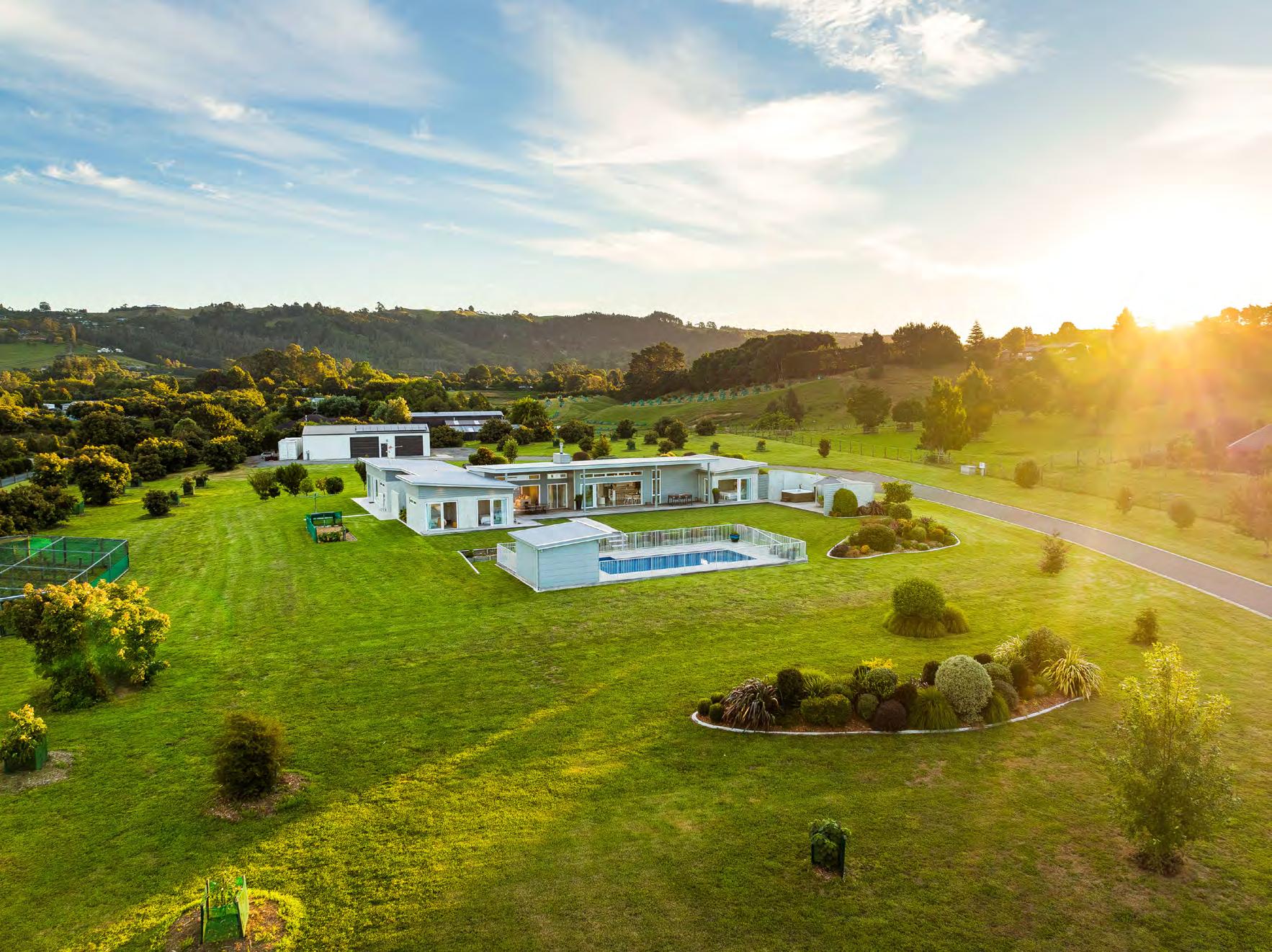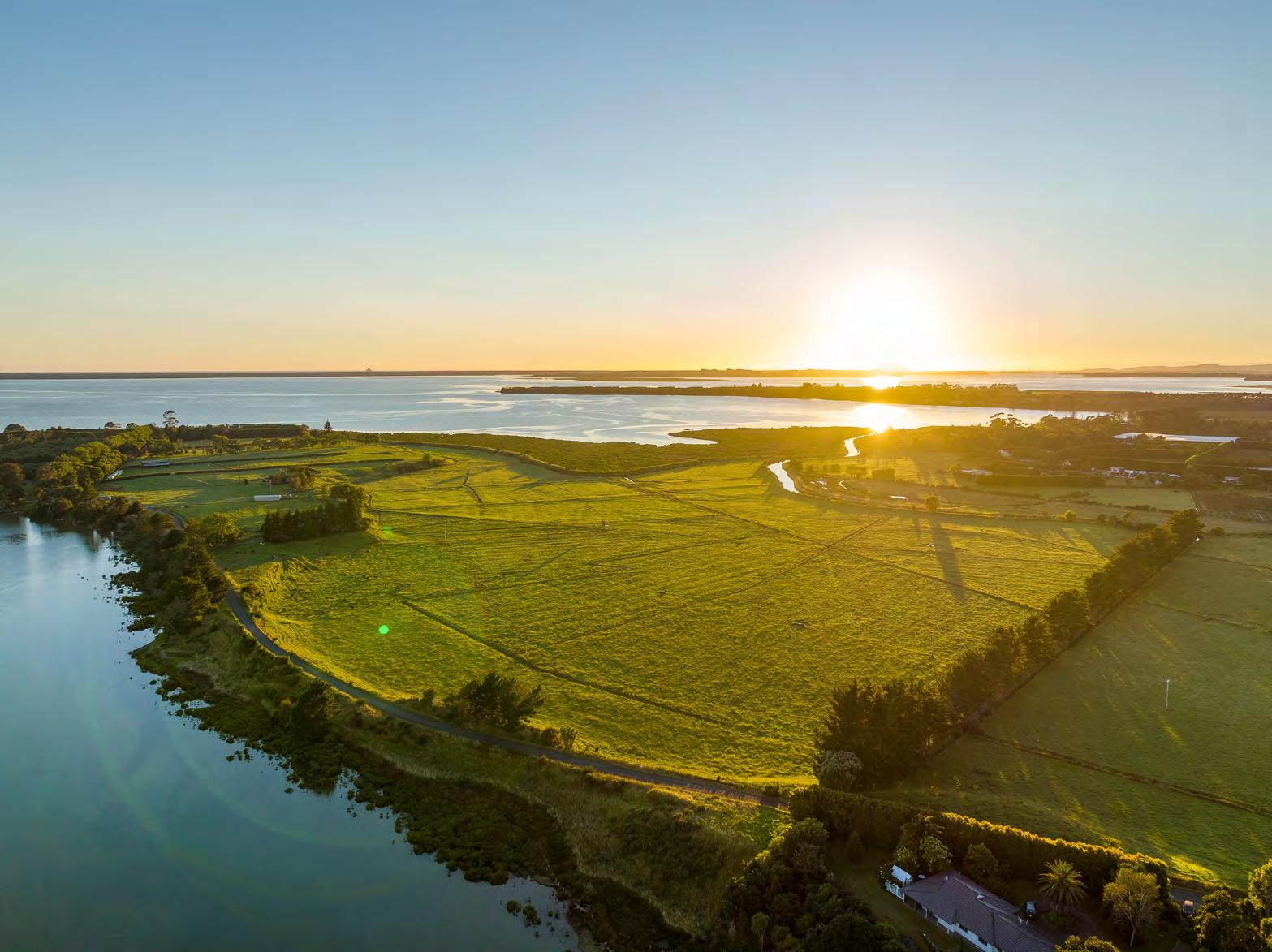
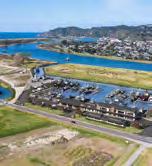





















The face of philanthropy in the WBOP is undergoing a profound shift, according to the Acorn Foundation. The change is from a world that was previously occupied by only the wealthiest to one where increasing numbers of people can choose to participate.
The Foundation is experiencing a rise in the number of local people wishing to donate to charities in a more strategic way and considering the long-term impact of their gifts.
“Over the past year alone, we’ve seen an increase of nearly 50 percent in our funds under management, as more locals are choosing to set up endowment funds with Acorn,” said Acorn Foundation chief executive Lori Luke.
“Our Smarter Giving Model differs from that used by individual charities,” she said.
“Community Foundations invest gifts so they can keep growing and contributing to the community for years to come. It’s an idea that’s very appealing to Acorn’s 400+ donors, who want to help provide sustainable, long-term support to causes they care about.”
Well-established model in North America
Lori, who grew up in the US, says the Community Foundation model is a well-established form of giving in the States and in Canada, but has only taken off across New Zealand in the past decade.
“This kind of strategic giving has traditionally been out of reach for many Kiwis,” said Luke.




“Before, you would have had to set up a charitable trust, which is both expensive and a heavy administrative burden. But Community Foundations like Acorn are making it much easier and more cost-effective to participate in long-term charitable giving.
“A fund with Acorn allows donors to choose their recipients and receive associated tax benefits for living giving, such as up to a 33.3 percent tax credit this year on donations made before 31 March.”
The growing popularity of this type of giving is projected to bring enormous long-term benefits to the Western Bay of Plenty region. Last year the Acorn Foundation distributed over $2 million to the community – reaching $10 million in collective contributions since its inception in 2003.
Luke said the future looked very bright for Acorn’s support for the wellbeing of the region.
“The fund is approaching $60 million now and models project Acorn distributions to the region will be over $5 million a year within 10 years and up to $10 million annually in 20 years, due to the substantial growth expected in the size of the fund.”
According to Priority One chief executive Nigel Tutt, strategic giving through the Acorn Foundation









will provide a substantial boost to economic and social development in the Western Bay of Plenty region.
“In a growing region like the Western Bay it’s important that wealth and funding is distributed to those in need so that no-one in our community is left behind.
“Acorn are a great contributor to the local community and with the rapid and substantial growth of their fund their impact in this region will only continue to grow in significance and demonstratively contribute to a more sustainable and supported community across all sectors.”
Besides the growth in the Acorn Foundation, New Zealand’s network of 17 Community Foundations have collectively seen a rapid growth in endowment funds of 33 percent in the past year alone;. With over 1,800 Community Foundations worldwide, it’s not hard to see why this type of giving has been described as ‘the fastest growing form of philanthropy in the world today’.
www.bopbusinessnews.co.nz
CONTACT INFORMATION
PUBLISHER
Alan Neben, Ph: 021 733 5366
Email: alan@bopbusinessnews.co.nz
EDITOR
David Porter, Mob: 021 884 858
Email: david@bopbusinessnews.co.nz
PRODUCTION – Copy/Proofs/Graphic Design
Times Media – Clare McGillivray
Email: clare@times.co.nz
ADVERTISING INQUIRIES
BUSINESS DIRECTOR
Pete Wales, Mob: 022 495 9248
Email: pete@bopbusinessnews.co.nz
ELECTRONIC FORWARDING
EDITORIAL:
News releases/Photos/Letters: david@bopbusinessnews.co.nz
GENERAL INQUIRIES: info@bopbusinessnews.co.nz
Bay of Plenty Business News has a circulation of 8000, distributed throughout Bay of Plenty between Waihi and Opotiki including Rotorua and Taupo, and to a subscription base. www.bopbusinessnews.co.nz
Bay of Plenty Business Publications 309/424 Maunganui Rd, Mt Maunganui, 3116
Bay of Plenty Business Publications specialises in business publishing, advertising, design and print media services.
These are strange times. We are all grappling with the niceties of the government’s new “traffic light” regulations, and we have seen a small but determined group of anti-vaxxers proclaiming their freedom to basically do whatever they like.
The major event of the past few weeks has centred on Parliament grounds in Wellington. As we went to press, the fracas outside Parliament Buildings seemed to be reaching its end. However it ends, it has lessons for us all.
Sociologist and gang expert Jarrod Gilbert spoke kindly of police commissioner Andrew Coster’s initially measured approach to the protestors. But in a recent op ed he acknowledged that Coster made an error in threatening to remove the protest vehicles blocking the Parliament surrounds – and then backing down. “That emboldened the protesters, while undermining public confidence in the police approach,” wrote Gilbert.
Perhaps equally stirred by the spectacle of Canada (Canada!) finally reaching the end of its tether with its own convoy protestors and moving in to physically remove them, the NZ police eventually opted for a pre-dawn raid.
However, it seems that among the major problems that tipped their hand was the disgusting spectacle of some protestors hurling faeces at the police from the portaloos thoughtfully supplied by some protestors. As well as reports
that battery acid was hurled at police.
As Gilbert put it, the only answers to the anti-mandate protests seemed to be more questions “and the only certainty is anger”.
Now I count some anti-vaxxers amongst friends and family members. Being fully vaccinated, I am happy to agree to disagree with them. I find it ironic that people who I know to have been heavy
It’s all very well to offer to negotiate reasonable demands, but exceedingly difficult to do so, when no one agrees who is a valid representative amongst the protestors.
New Zealand is a strange country. I was peripherally involved in covering the national protests when the Springboks toured NZ in their ill-judged 1981 apartheid-era appearance. The protests threatened to tear the country
As Gilbert put it, the only answers to the anti-mandate protests seemed to be more questions “and the only certainty is anger.”
consumers of dangerous substances in their younger years – and sometimes still – have the effrontery to protest the reasonable request that crowd situations create the need for a degree of safety precautions.
But aside from the fact that the Parliament protests seemed to be a classic example of a superspreader event, one of the major problems is that there appear to have been no agreedupon demonstration leaders.
apart. I lived for many years in Asia and was saddened when mainland China decided to choke off anything resembling genuine protests when it took over full control.
I am not arguing for a return to days long ago when the police sometimes resorted too often to baton control.

Well-regarded local business leader Marty Verry, chief executive of Red Stag, contributed a recent op ed explaining why he supported the protest; His argument largely seemed to revolve around the viewpoint: “The risk-reward of opening the borders to quarantine-free travel has become the most asymmetrical no-brainer in the history of economic management… My hope is the protests will push the government to do the maths.”
Whilst I agree the current government is made up of people with very little personal experience in risk-taking, I suspect Verry is unlikely to find that the sprawling, disconnected rabble of protestors who have been obstructing struggling nearly businesses is likely to gain much support inside or outside Parliament. I do agree with Verry’s point that the protest represents a groundswell of Kiwis pushing the government to transition faster to the post-Covid restriction-free era. However, I doubt it will have the required effect. Rather, and inevitably, it seems to have hardened the viewpoints of the more or less 95 percent of Kiwis who are already vaccinated.

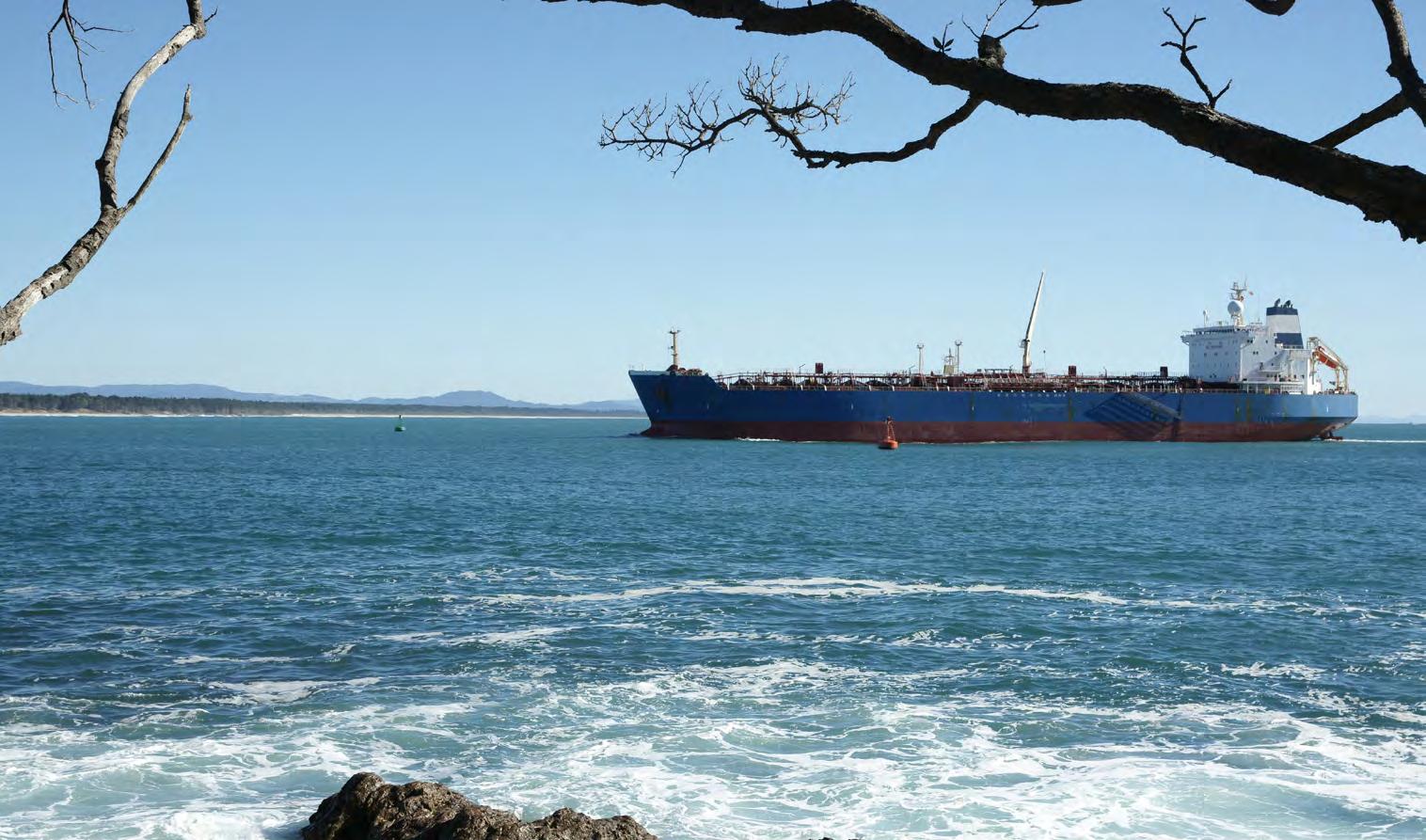
With the exporting season in full swing, the grief experienced with shipping delays and capacity constraints last year is unlikely to ease much this season, according to expectations.
By RICHARD RENNIE
Port of Tauranga CEO Leonard Sampson is cautioning that while somewhat improved from last year, shipping schedules remain far from reliable.
“On a general level where we are at present is that shipping services are still off their scheduled berth windows with only 40 percent of vessels coming into Tauranga able to meet their agreed berthing window.”
Globally, shipping schedule reliability fell to a historical low of 35 percent last year.
The cumulative effect of late vessels cascaded through last year’s total capacity at Tauranga.
Last year, vessel rotation on NZ-Australia-Asia routes was typically taking 63 days, with six vessels, against a usual 49-day rotation.
Sampson said that while there had been some improvement this year, the rotation was still short of the pre-covid 49-day rotation.
“And it is going to take new shipping capacity to increase that. Ship-building companies have the second-largest order books in history right now, and it will take two to three years to complete those vessels.”
Cargo flow improved
The good news in recent months was that the cargo flow out of Port of Tauranga to Auckland had been much improved, thanks to increased rail capacity, which meant there were now 92 trains per week running Tauranga-Auckland.
This was aiding significantly in getting imported product away and reducing the volume of containers held in Tauranga by 20 percent on a year ago.
He said the arrival of Israeli shipping company ZIM had also helped with capacity.
A Port of Auckland spokesman said the port was operating better than it had a year ago when staffing and automation issues were stifling throughput.
However, he said like every other business the port continues to wrestle with staffing constraints.
Globally, the impact of omicron was being felt remotely from New Zealand, because of the major shipping delays being experienced in some of the gateway ports for New Zealand products.
Long Beach California was reporting over 100 ships at anchor awaiting discharge or loading, three times that of a year ago.
Thanks to omicron infection and resulting absenteeism in port workers and truck drivers, major delays are being encountered.
China’s ongoing aim for “zero Covid” is also having a hard impact in some of its major ports.
Dalian, a major chilled and frozen goods port, was one of the first to experience an omicron outbreak and subsequent shutdown.
David Ross, chief executive of freight company Kotahi, said shipping reliability late last year got worse before it got better, declining to a
low point of 32 percent in December, the worst in a decade.
“This amounted to an average of seven-day delays for vessels, effectively contributing to 11.5 percent of the global vessel capacity being lost.”
Delays to the US West Coast are particularly bad, with New Zealand exporters losing 35 percent of their usual capacity to that destination.
“That is worse than anyone planned for.”
While things were not getting any easier, Ross said the good news was an improvement in New Zealand shipping schedule reliability, with key ports like Tauranga now over 40 percent and moving in the right direction.
Tauranga moving in right direction
“And that has been enabled through investment by Maersk to stabilise key services. The addition of the Southern Star service through to Asia has added capacity.
“Adding the Polaris service to stabilise calls to the Port of Timaru to link to the Southern Star service has had ships hitting 100 percent of their berthing windows and enabled much better connections.”
With primary sector exports ramping up, Ross said there could be a challenge to refrigerated container supplies here, with possible pockets of shortages in regions arising.
But delays in scheduled sailings and congestion in destination ports was forcing some exporters of chilled products to reconsider their market reach, depending upon the number of
connections involved in getting chilled product to shelf.
“We had quite a lot of success last year with our strategic partners adjusting plans to better suit what was there. We think that approach with learnings from last year will bring a more reliable supply capacity to customers than they may otherwise get.”
Kotahi’s two main strategic partners are Fonterra and Silver Fern Farms.
Better but not great
Ken Harris, director of Container Co., New Zealand’s largest container company, said supply of containers for the export season was generally looking reasonably sound.
“It is better than last year, but it’s still not great.”
Last year his company had experienced a slide in container supply from 21 days to only five, and shipping companies remained reluctant to ship back empty refrigerated containers when rates for full boxes were so high on other routes.
“And most of our refrigerated containers will come back empty.”
He anticipated the crisis will drive changes in shipping routes, with companies under pressure to drop some ports not seen as essential. His company was looking to invest in Western Bay of Plenty with a container facility near Te Puna to manage containers destined for packhouses that do not need to be freighted back to the port facility.
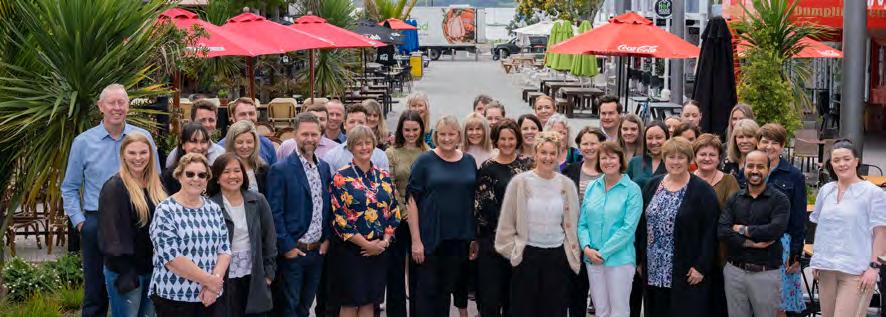

The Bay’s TECT Park has been recognised as a top 10 winner in the Green Flag International People’s Choice Award.
By DAVID PORTER
The 1650-ha TECT Park in Upper Pyes Pa, is a joint venture between Western Bay of Plenty District and Tauranga City councils. The awards see Green Flag Award winning parks from around the world entered into a people’s choice contest, and the top park from each nation claims a coveted spot in the top 10.
As the highest-voted park from Aotearoa New Zealand, TECT Park carries the mantle for New Zealand. That puts the park in company with some international big hitters, including Presidio of San Francisco (USA), which was visited by 12.4 million people a year (pre-COVID).
Western Bay Mayor Garry Webber said the award is well deserved, “TECT Park has only been in existence 11 years and in that time it’s won award after award. Now it sits among the world’s most loved Green Flag award winning parks. I’m thrilled to see the park and the management team’s hard work recognised.”
Outstanding recognition
Tauranga City Council Commission Chair Anne Tolley said TECT Park’s latest recognition was simply outstanding.
“This shows what three committed organisations, a great management team and the people of the Western Bay can achieve, and that’s to create a superb recreational resource and place it firmly on the world map. Congratulations go to everyone involved.”
TECT Chairperson Bill Holland said: “TECT Park is the flagship park not only of our region, but of our country and the world, and it is fantastic to see it recognised with this award. To win the People’s Choice Award for New Zealand is an astounding achievement, one that goes to show the level of time, work and funding that has gone into making it what it is today – a place everyone can come to enjoy nature and get active.
“We are incredibly proud to be a long-time supporter and key funder of the park. Congratulations to all those involved in helping make the park one of the best in the world – we’re lucky to have it right on our doorstep.”
“Little TECT Park is hanging around in some pretty illustrious company,” said TECT Park Manager Bill Wheeler. ”We are doing well to even feature on this kind of list and that’s all down to the support of the users from all over the Bay.”
“This really was the people’s choice, they have supported us and shown how much they really appreciate the work that both Councils have put into providing the Park facilities by taking time to vote. They will continue to be far stricter judges than Green Flag will ever send but they are also our greatest ambassadors.”
The top 10 status puts TECT Park on an international stage among parks from North America, Australia and Europe.
A new boat harbour proposed for Whakata ne is one step closer to construction with the recent formalisation of a partnership between Te Ra hui Lands Trust, Whakata ne District Council, Nga ti Awa Group Holdings, the Crown via Ka noa – Regional Economic Development & Investment Unit, and agreement from landowners to progress the development.
By DAVID PORTER
Once completed, the development will provide commercial boat operators on New Zealand’s East Coast with access to better facilities and more berths while increasing economic returns for the local community. However, it involves a number of different groups and Bay of Plenty Business News understands it has taken some time to resolve the complexities involved.
Project director Phil Wardale confirmed to Bay of Plenty Business News the project had now gained approval to utilise the government’s FastTrack consenting pathway, which enables a more streamlined consent approval process. This is designed to support New Zealand’s recovery from the economic and social impacts of Covid-19.
“Fast-tracking the consenting application means the review and processing time frames are condensed,” he said. “This means it’s up to us as a project team to ensure we have provided a robust and well considered application that answers any and all questions that may arise.”
The $29.4 million Boat Harbour aims to ultimately provide for 800 new jobs, including 218 existing jobs in Whakatāne’s marine and tourism industries. Around 30 people will be involved in its construction on a full-time basis, many of them from Ngāti Awa, who will be reskilled or upskilled via training providers to support the project’s contractors.
New jobs to be created
Organisers said the project will initially create the equivalent of at least 30 full time jobs during its construction, and longer term is expected to create upwards of 600 of new jobs and flow-on economic benefits for Whakatāne.
As part of the project, areas of wetland will be restored and improvements made for pub-
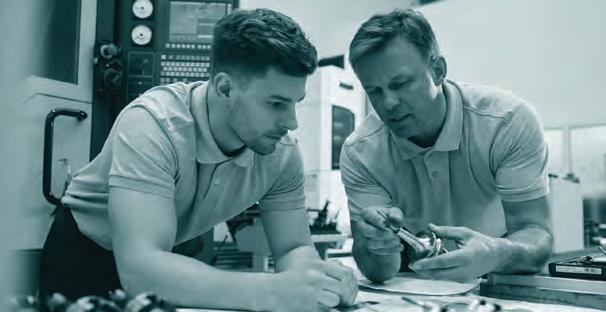
“There will be ongoing work to ensure the sustainability of the improvements, but I feel we are already on the front foot as assembly are inspired and excited about the change, now they are part of the solution rather than being made to feel like part of the problem.”
- Product Development Manager Tauranga

lic and recreational use of the Wairaka area, where boats are currently berthed.
Funding of $19.6 million has been provided by the Crown via Kānoa – Regional Economic Development & Investment Unit – for the build of the boat harbour, and $9.8 million is to
The project forms a key part of our District’s economic development strategy, which is further magnified by our need to respond to Covid and its impacts.
be contributed by Whakatāne District Council, with Te Rāhui Lands Trust providing the site.
Named Te Rāhui Herenga Waka, the boat harbour will be located adjacent to the Whakatāne River, on land that
has been unproductive for many decades.
Berthage in Whakatāne is currently restricted by capacity at the town wharves, so it will provide safer and more resilient berthage facility initially for around 60 commercial vessels working as commercial charters, in aquaculture and fishing, from 14 to 30 metres in size.
It will also offer a travel lift of 80-100-tonne capacity, providing a new option for vessels to be hauled out and undergo maintenance on New Zealand’s east coast, where there is demand for, and a shortage of facilities.
In future stage of the project, berthage for recreational boats, a boat ramp and additional commercial premises are proposed to be developed.
Restoring river connections
Te Rāhui Lands Trust Chairman Brian Simpson says the project will restore the connections and mauri of the river for future generations, and enable key outcomes for the Trust to be achieved.
“The project has empowered us as Kaitiaki to utilise our whenua in a way that respects and protects the dynamic river environment and provides
employment and training for our owners and Ngāti Awa.”
Whakatane mayor Judy Turner said: “Council has long supported the development of a new boat harbour to further unlock opportunities in our local marine and tourism sectors, and to drive wider economic, social and environmental benefits.
“The project forms a key part of our District’s economic development strategy, which is further magnified by our need to respond to Covid and its impacts.
Simpson acknowledged East Coast MP Kiri Allan as a key player in supporting the Trust and partners to reach agreement.
“We recently met with Kiritapu Allan and were excited to share the news that the partnership had been formally established. Allan said the formalisation of the partnership represented an important milestone in the region’s economic development. “I congratulate the partners on the hard work to date and look forward to seeing the project come to fruition,” she said.
Community engagement will be ongoing as the project moves through the consenting process. Subject to receipt of consents, construction is expected to begin the second half of 2022.
You have the vision and motivation that took you this far. You have big goals. Now take command. Apply the proven tools, expertise and support of Dale Carnegie and watch the effects ripple out. From individual breakthroughs to transformed relationships. Radically changed team performance. Measurable results. Organisational impact. And reshaped communities.
At Dale Carnegie, we’ve helped thousands of organisations and millions of individuals take command – of their businesses, their careers, their futures. Dale Carnegie BOP Waikato 07 579 0484
www.bop-waikato.dalecarnegie.com
For a small tax, collecting only around $600 million per annum, fringe benefit tax (or FBT) punches above its weight in terms of the amount of angst caused to employers.
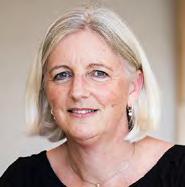
> BY ANDREA SCATCHARD
Andrea Scatchard is a Tax Partner at Deloitte, based in the Bay of Plenty. She can be contacted on ascatchard@deloitte.co.nz
or local employers, the ongoing changes in relation to close v casual contacts, self-isolation periods and rules around when you need to stand down staff because someone has tested positive, are extremely challenging to navigate. Especially as we head into the kiwifruit harvest season.
Employers will naturally be doing everything they can to keep their workforce safe and well so that they can continue working. And while tax generally will not be a high priority in these considerations, it is worth considering the possible tax consequences of actions employers may be contemplating (or may have already implemented).
Incentives for vaccinations
Businesses across New Zealand have been offering employees incentives to get their vaccinations. This has been most commonly in the form of one-off cash payments or gift vouchers.”

to Inland Revenue. For an employee on the 33 percent tax rate, this is effectively a 49.25 percent increase in the overall cost and will be more once KiwiSaver etc are taken into account.
all unclassified benefits provided to all employees does not exceed $22,500 in the last four quarters (or per annum for annual filers).
It’s a win-win, as employees receive the incentive and can return to work in a safe environment with their peers while businesses can continue to engage with customers and the wider community with lower risk and higher confidence.
A cash bonus paid to an
Just as “two shots for summer” was an effective incentive to get Kiwi’s vaccinated before the Christmas break, businesses across New Zealand have been offering employees incentives to get their vaccinations. This has been most commonly in the form of one-off cash payments or gift vouchers.
employee for getting vaccinated is linked to their employment and as such is taxable employment income.
Employers should deduct PAYE from such cash incentives paid to employees, and the payments may also be subject to other withholding such as KiwiSaver deductions or student loan repayments.
If the employer wants the employee to receive, for example $100 in the hand, that amount will need to be grossed up for the PAYE and other deductions to calculate the gross income to report
Where a non-cash benefit such as a supermarket voucher or Prezzy card is provided instead of a cash payment, these will be subject to fringe benefit tax (FBT), unless the employer qualifies for the de-minimis exemption that applies to unclassified fringe benefits.
This exempts unclassified benefits where:
• the value of unclassified benefits each employee receives does not exceed $300 per quarter for a quarterly FBT filer or $1,200 per annum for an annual FBT filer; and
• the total taxable value of
If either of these thresholds are exceeded, all unclassified benefits, including any vouchers provided for vaccinations, are subject to FBT.
Some employees will be required to be vaccinated to be able to continue working, because any incentive provided by employers is not linked to reimbursing the cost of getting the vaccine. The exclusions from FBT and PAYE that would usually apply where the employer covers the cost of flu jabs for employees will not apply.
WFH allowances
Under the current Red setting of the Covid-19 Protection
Framework, there are many employees that are either working from home full time or who are doing day or week about in the office to minimise the risk of large numbers of employees either getting Covid-19 or being considered close contacts.
Inland Revenue has issued guidance (in Determination EE003) on when allowances paid to staff to reimburse them for the extra costs incurred while working from home can be treated as tax free. This includes general reimbursing payments as well as specific ones for telecommunications costs and to cover the cost of the employee buying equipment to use at home. If this is something you have done, or are considering, it is worth reading this and getting advice on the tax treatment of such payments.
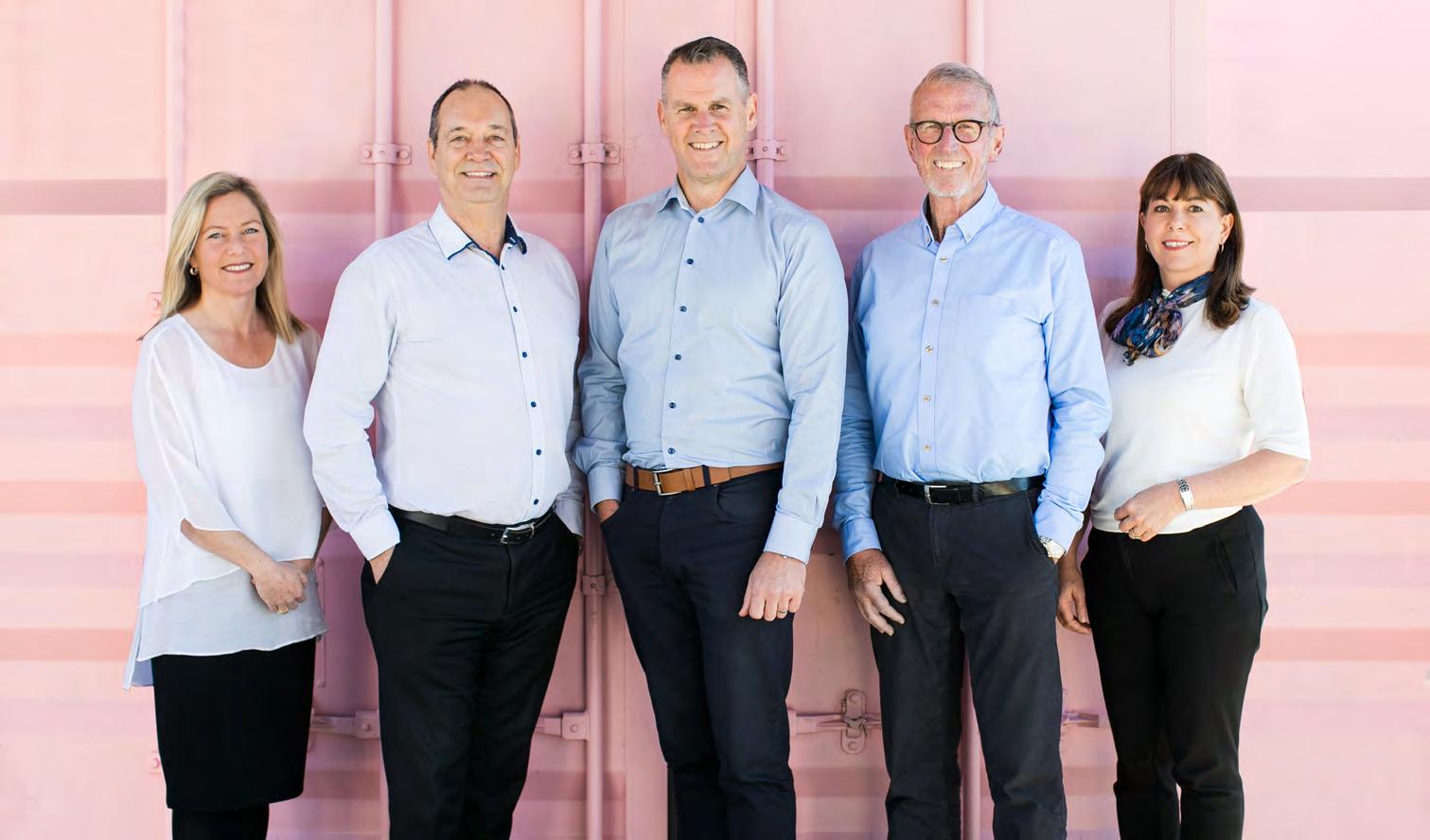

As IT recruiters and businesses continue to face a shortage of skilled workers in New Zealand, “ICT Security Specialist” is appearing on Immigration New Zealand’s list of long-term skill shortages. The New Zealand government has responded with a roadmap to close the gap in critical digital skills that is impacting the entire economy.
With the technology sector growing at almost twice the rate of the rest of the economy, contributing an estimated $6.6 billion to the economy in 2019, the digital technology sector is now one of the country’s top earners.
At the time of writing this there are currently 14,388 vacancies under Information Technology with 255 of those being senior Cyber Security analysts.
To keep up with this demand, between 3500 and 4500 IT visas were issued each year for five consecutive years. But with the closing of borders due to Covid-19, the major source of advanced skills and experience needed to fill these roles was turned off. Further adding to the increased skill shortage in an industry that continues to grow.
Identifying pressing issues
In early 2021 The Skills Workstream assembled a report to identify what the pressing issues were and stated that we have an over reliance on

> BY MARIETTE TOLMAY
Mariette Tolmay is the marketing lead at Stratus Blue. She can be contacted at mariette@stratusblue.co.nz.

immigration, with over 55 percent of roles being filled with international talent vs domestic and noted this was simply unsustainable. It also listed that there is a significant mismatch between the skills available and the skills needed by our industry. It’s not just about more people. And most importantly, if we want to solve the skills challenges in our sector, Industry, Government, and the Education Sector must work together, all play a crucial role, and the level of engage-
ment and investment needs to increase significantly.
On 14 February, 2022 the Government proposed major changes in the ways it currently supports the tech sector’s growth.
The digital technologies sector draft Industry Transformation Plan (ITP) aims to address how the Government can work with the industry to increase the sector’s contribution to New Zealand’s gross domestic product (GDP), as well as increasing export revenue, creating more job
opportunities, and improving diversity.
Alongside the announcement that there will be 600 border exceptions for tech workers in identified roles being: ICT management, ICT security specialist, software and application programmers and multimedia specialist an action plan has been developed to address the principles found in the Skills Workstream report.
The government proposed it will address the findings in the following ways:
• By ensuring the sector can attract the skills it needs to grow all levels and that it is creating high-quality jobs for all New Zealanders, including those groups currently under-represented
• By increasing the number of globally successful New Zealand Digital Technologies exporters, with a focus on the intellectual property producing business models of software as a service and interactive media
• By proposing actions that empower Māori to increase their participation in the sector, as business owners, entrepreneurs and in the workforce
• By improving international perceptions of the sector and attracting both local and international investment and talent. It will achieve this by ‘crafting and promoting a compelling story that confirms New Zealand’s worldclass tech and innovation capabilities’
• By ensuring all sectors of the economy gain greater understanding and appreciation of the economic value of data, leading to increased
adoption and use of datadriven technologies, including artificial intelligence, with flow-on benefits in terms of reduced emissions and greater productivity
By defining New Zealand’s approach to supporting the ethical adoption of AI, helping grow a thriving AI ecosystem and ensuring the safe adoption and use of AI in New Zealand By improving working relationships between the sector and government to ensure procurement delivers fair and accountable outcomes and value for money for New Zealanders. It must also be well regarded domestically and internationally for supporting innovation and the ingenuity of tech companies.
MBIE is now seeking feedback on the draft Digital Technologies ITP, including its scope, vision, and proposed action plan. An ITP is a sector-based development plan, jointly produced between industry, government, academia, and Māori, as a Te Tiriti partner. Submissions close by 5pm on 31 March, 2022.
As part of Tauranga City Council’s forthcoming 2022/23 Annual Plan and 202131 Long-term Plan Amendment processes, the Commissioners want to hear from the business sector on a proposal that aims to achieve a fairer overall rates funding balance for our community.
By ANNE TOLLEY, Tauranga Commission Chair
The aspect we’re most interested in is understanding who benefits from the investments the Council is making in the city and focusing on delivering projects that provide consistent and reliable levels of service, particularly in our transport network.
Research undertaken by Council staff indicates that at present, just over half of the trips on our roading network are business-related. As it stands, commercial and industrial rates contribute just 20 percent of our transport rates revenue, which clearly raises questions about the fairness of the current rates structure.
We’re keen to explore ways to address that equity issue by increasing the commercial differential on general rates and the transportation targeted rate, so that half of our transport costs would be paid

by commercial and industrial ratepayers.
This is an important decision, because we’re planning to invest close to $1.6 billion in transport improvements between now and 2031. That investment programme features major projects to address congestion issues on 15th Ave/ Turret Road; and the Hewletts/ Totara/Hull Roads sub-catchment; plus growth projects in the eastern (Te Tumu) and western (Tauriko) corridors; work to facilitate Te Papa pen-

An
impression of the Cameron
at 6thAvenue,Tauranga, illustrating the multi-modal elements of the current upgrading project.
insula intensification (including Cameron Road stage 2 works); and general road renewals and upgrades.
Businesses under economic pressure
The Commission is very much aware of the economic pressures many businesses are facing, as a result of the ongoing impacts of the pandemic and
border closures. While we obviously don’t want to make that situation worse, we also need to make decisions for the benefit of the whole city and as we all know, we’re playing catch-up on investments that should have been made in the past, but were put in the toohard basket.
By the time this edition is published, we will have ‘pre-engaged’ directly with
the business community via discussions with Priority 1 and Chamber of Commerce members.
Further discussions will take place during the Longterm Plan Amendment (LTPA) consultation period, which starts on 25 March and runs through to 26 April. We would encourage you all to read the LTPA/Annual Plan consultation document (available via
the Council website throughout the consultation period) and send in a submission for us to consider before making final decisions on these important plans at the end of June. If you would like to talk to us directly about any concerns or suggestions, please email Maree King (maree.king@ tauranga.govt.nz) to arrange a time in one of our upcoming clinics.
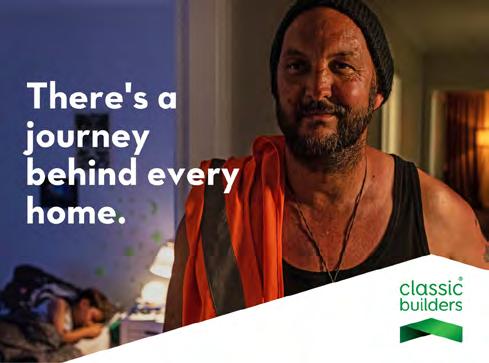
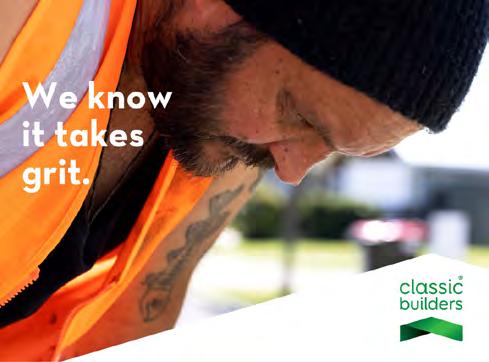

The road to home ownership is a tough one for most New Zealanders, even more so today with the New Zealand median house price sitting well over $800,000, with Auckland now well over $1,000,000. So how on earth do Kiwis do it? It’s about being determined, focused, and utilising a key Kiwi strength, grit.
Classic Builders has been around for 25 years now, witnessing property booms that have driven prices up well beyond previous limits, and lifestyle changes that have seen storeys go up and section sizes shrink.
But no matter what the market is like, it’s commonplace for Classic to hear their clients’ stories of struggle and persistence, saving what is required for them to secure and then service their own home in order to
By DAVID PORTER
Last month Bay of Plenty com-
pany Fertco purchased Te Awamutu-based fertiliser company TerraCare from the Macky family.
Fertco, based near the Port of Tauranga, currently services the BOP, Waikato, and King Country regions, while TerraCare, with a factory in Te Awamutu, has a customer base in the Waikato, King Country, Manawatu, and lower North Island.
Fertco and TerraCare have shared similar philosophies with regard to looking after clients and the environment, and Fertco aims to add TerraCare’s branded products to its range, and the acquisition seemed a logical solution for both companies.
Company officials described the purchase as akin to an amalgamation of the two companies, rather than one
build a better life for themselves and their loved ones.
Classic has just released a visual campaign that acknowledges this, reflecting that the journey to home ownership in New Zealand takes true grit.
The campaign – which is being streamed and features on digital platforms – has been created by this leading New Zealand building company, in collaboration with design and marketing agency We Are Society, and
film director Chris Clark.
Classic Group’s managing director, Matt Lagerberg, says that, while owning a home should be possible for everyone, it now requires more effort and grit than ever before.
“Having built over 6,500 homes now, we see how hard it is and that makes the part we play even more significant. We have to make all the hard work worth it,” he says.
“The building industry here in New Zealand has intertwining issues
that require critical attention, from legislation and vital infrastructure through to innovation and recycling.
Classic is investing time and capital into helping drive change and address these issues, but this will take time and funny enough, a whole lot of grit.”
It’s important for Classic to stay committed to both our clients today, while being focused on our future ones. We are determined to build more homes for Kiwis and that means addressing affordability and future supply,” he says.
It was only in October that the Classic Group was in the news thanks to the $300m Kaha Ake partnership they have established with NZ Super Fund, aimed at delivering thousands
of new homes for New Zealanders.
“This partnership will enable Classic to deliver more home ownership opportunities all over New Zealand,” says Matt.
Classic’s national Grit campaign carries a “keep going and don’t give up” message and, in line with Classic Builders branding, touches on building dreams that create a future. It tracks the stories of three hardworking families/individuals, whose varied scenarios depict the constantly striving nature of Kiwis.
All show moments of hard grind culminating in a sense of reward – be it a hard-earned business or project success or… returning to the peace and security of your own home at the end of a gruelling day.
being taken over by the other.
“We’re very excited to be welcoming a new era for Fertco and TerraCare,” said Fertco’s chief executive Warwick Voyce.
“We’re aiming to learn from TerraCare’s IP so we can improve the offerings for both sets of customers.”
When Fertco was looking to extend its customer base into new areas, and TerraCare was seeking a buyer, the purchase seemed like the obvious solution for both companies.
TerraCare’s clients will still be able to get customised fertiliser recommendations based on soil and herbage tests as this has always been the Fertco way too.
They will still be able to purchase the same types of products that
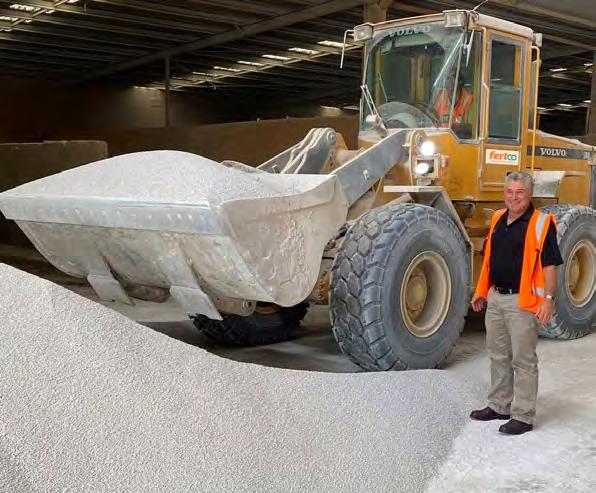

minimise environmental impacts, since these have also been a focus for Fertco, which the company says stock the largest range of organic products in New Zealand.
In many cases, TerraCare’s customers will still be dealing with the same Field Representatives who are with the Fertco sales team.
What will be different and part of the new era is the nutrient budgeting and compliance services that Fertco intends to offer all of its customers.
Warwick said: “Our team are very pleased to offer Fertco’s products and services to a greater audience of farmers and growers.
“We have long been asked to have a distribution option in the Waikato and we know this move will improve our service to current customers and encourages others to enquire as to how Fertco can help farmers have a better fertiliser experience.
The Forest Owners Association is telling the government that Australia’s support of plantation forestry is in sharp contrast to the increasingly restrictive measures being promised in New Zealand by our government.
Australian Prime Minister Scott Morrison recently announced an $86 (Aust) million package for forestry for Tasmania. Morrison said the biggest government forest support package for more than 30 years would leverage at least $300 million in total investment into plantations. He said global demand for timber products was expected to quadruple by 2050.
The President of the New Zealand Forest Owners Association, Phil Taylor, said the New Zealand industry was not seeking the type of financial support being delivered in Australia.
“Basically, all we want to do is get on with growing trees and responding to strong world and local demand. Our problem is a sequence of messages from the government on new rules to restrict forest expansion. [We recently] saw on the ‘Sunday’ programme the government was planning to put a stop to the right to convert a whole farm to forestry.”
Taylor said that if there was a problem with carbon farming, then that should be treated separately.
“A modest expansion of the exotic plantation estate is vital to provide enough carbon sequestration capacity for the government to budget for a carbon zero economy by 2050. The right signals have to be sent to farmers and other landowners to ensure this happens and these are not the signals we are getting at the moment.”
Anyone who was in the UK (or supported the English football team) in 1996 will undoubtedly remember the dulcet tones of David Baddiel and Frank Skinner as they ‘sang’ ‘Three Lions’ in support of England’s Euro 96 campaign.
How could you not? The song blared out of every radio on every building site and in every home at all hours.
Alas, poor England, they did not win…again…and the trophy did not come home.
But something that is – or at least appears to be – coming home (to New Zealand, that is) is the country’s intellectual property.
To be more specific, Kiwi businesses appear to be either moving production of their goods back to New Zealand or just making it here in the first place.
Bringing IP home
I know of at least three businesses in the Waikato and Bay of Plenty who have brought, or who are in the process of

> BY BEN CAIN
Ben Cain is a Senior Associate at James & Wells and a Resolution Institute-accredited mediator. He can be contacted at 07 928 4470 (Tauranga), 07 957 5660 (Hamilton), and benc@jaws.co.nz.
bringing, their manufacturing – and therefore their intellectual property – back home to New Zealand from China.
One recent example is Ego in Hamilton, who, in the January/February 2022 issue of Waikato Business News, was reported as having plans to “shift manufacturing from China to New Zealand in the very near future with the Auckland base destined to be the manufacturing plant, design studio and showroom all in one”.
I also know of start-up businesses who are not even considering manufacturing in China: they want to manufacture at home.
The big question, of
By ALAN NEBEN
When Santa Fe Shutters’ owner Gail Christie and her husband Paul bought the business 20 years ago, they had three employees. Fast-forward 20 years and they now employ 105.
Yes, that’s Gail – you will no doubt have seen as the face on Santa Fe Shutters’ signage and fronting their advertising campaigns. Personality seems to shine through when you meet Gail face to face.
But Gail is quick to correct me when I say the 105 staff work for her.
“They don’t work for us, they work with us – we’re a team,” she says respectfully.
And part of what makes them a team – an incredibly successful team – amongst other things is their focus on technology.
Unlike the early days, the company is no longer just supplying Bay of Plenty clients – the brand is now recognised as a national leader in its field.
“We’ve had a number of challenges in recent times,” admits Gail.
When Covid initially impacted the business, there were hold-ups for supplies coming out of China. Then when New Zealand went into lockdown, China was catching
up and the supply chain became stretched.
Like many businesses across the country they were forced to shift gears from a just-in-time stock model to a just-in-case one. That brings with it new challenges and extra overheads.
One of the company’s goals was to grow it’s manufacturing in New Zealand as well as overseas.
That was part of the motivation for the purchase of Bay Blinds four years ago. They now offer a wider range of window solutions throughout the entire country, both blinds and shutters.
Santa Fe relies on Vodafone Business for its communication technology solutions.
“We operate about 30 mobiles and high-speed quality internet has become critical to our growth in recent years, particularly with the constraints and safety implications which Covid has introduced,” says Gail.
“We couldn’t operate our business without the mobile technologies we have. From the factory floor to the remote sales team members out in the field, good mobile comms are critical.”
In fact, Gail goes a step further. She is adamant there has been an upside to the Covid restrictions for the business: they now use video
communications for most sales and training around the country –something they wouldn’t have seriously contemplated three or four years ago.
“It’s faster, it’s more efficient and it just makes sense,” she says.
And its not only the trade customers who benefit.
“We have consumer clients who have been delighted to see we have introduced video measure and consultation sessions.”
Although this option was only introduced as a Covid safety imperative, Gail predicts it could be here to stay.
Vodafone’s technology gives a real edge
Vodafone is helping the BOP region to thrive via remarkable technology.
In February 2021, Vodafone announced a turbocharged network investment program, spending hundreds of millions of dollars annually to better connect Aotearoa.
This included building or upgrading 800 cell sites nationally, in addition to adding more than 200 cell sites being built by the Rural Connectivity Group (RCG) over the coming 2-3 years.
Despite navigating the chal-
course, is why? The cost of labour in China, for example, is much cheaper and China has recognised technological and manufacturing expertise.
China is also geographically much closer to major markets like Europe, India and Japan, making distribution much easier than from New Zealand.
From talking to business owners, I believe the reasons are control, speed and (thanks to Darth Covid) cost. By control, I mean control over their IP, what happens to it, and who has access to it; by speed, I primarily mean speed of response to market and customer demand; and by cost, I mean, of course, the cost of
shipping goods to New Zealand which has dramatically increased over the last two years.
There’s no doubt that Covid has accelerated the movement to bring the country’s intellectual property home.
There’s equally no doubt though that China, for one, will remain a significant manufacturing source for New Zealand businesses. What remains to be seen is what balance will be struck between the two, and how Kiwi returnees and New Zealand government policies, for example, will influence the future of manufacturing in New Zealand.
BY VODAFONE
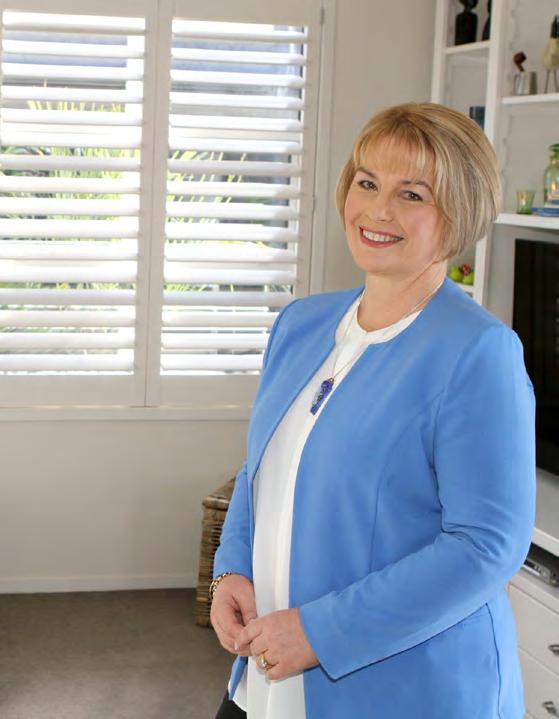
lenges of Covid-19 and additional health and safety measures, Vodafone upgraded 38 mobile cell sites and built 14 new cell sites across the region in 2021 in addition to eight new Rural Connectivity Group (RCG) sites. This has improved the critical digital services that keep people connected so they can work, learn and play remotely.
Vodafone first switched on 5G technology at the Mount in March 2021 bringing the latest generation mobile network tech to BOP – and now, after more investment in the BOP region, independent testing shows Vodafone offers custom-
ers the best mobile network in the BOP region.
The network improvements enable businesses to do what they do best, faster and more reliably, from any location. This allows them to focus on doing business and driving profits.
A robust network also means staff can work from anywhere, enabling a better work-life balance for those who want to work from home or from a bach while on holiday.
To learn more about Vodafone’s 5G network head to www.vodafone.co.nz/5g/
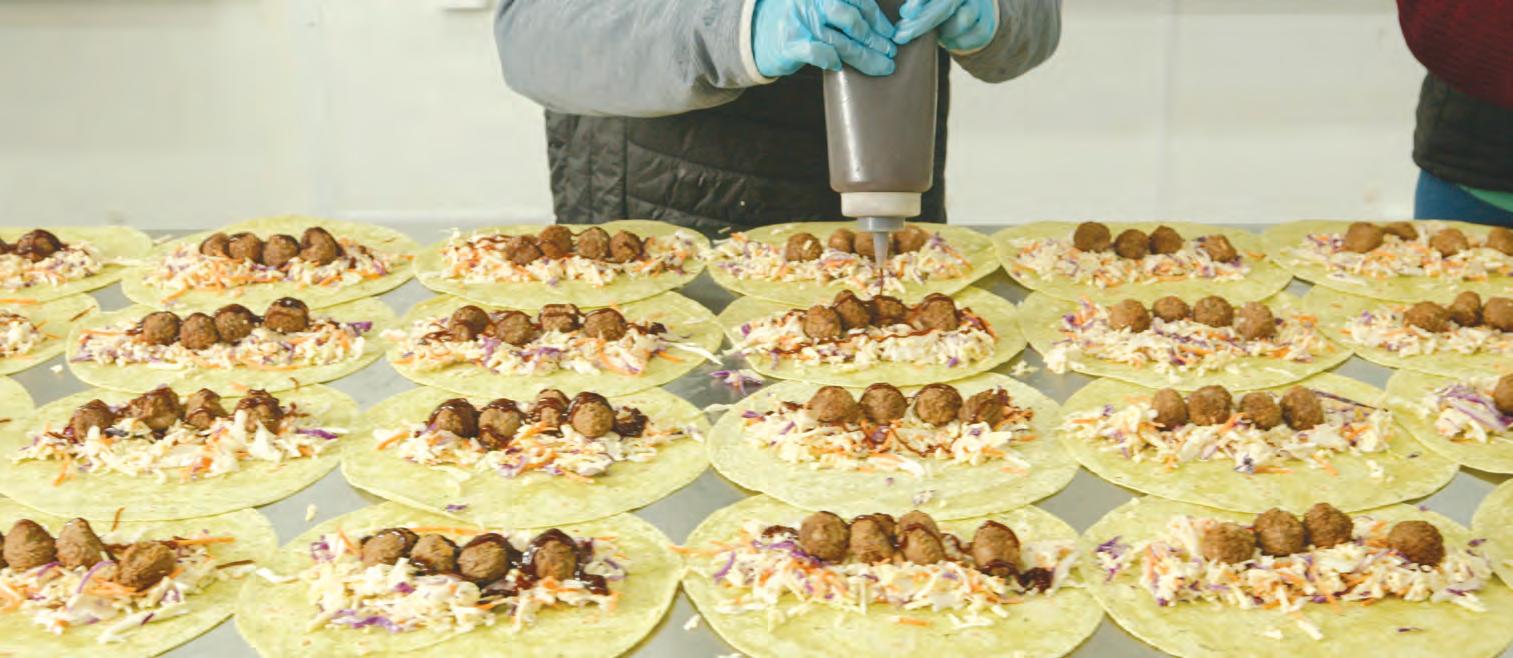
At the tail-end of 2020, Bay Venues established Healthy School Kai to cater for large schools in the area who had been chosen to participate in the Ministry of Education Ka Ora, Ka Ako | Healthy School Lunches programme.
Healthy School Kai delivers just under 4000 lunches a weekday to schools across Tauranga and Whakatane. This feeds many children who would otherwise go without lunch. Providing nutritious, wholesome food that will keep tamariki fuller for longer, so they are more alert, engaged, and active in class.
“We have a huge need for this programme. Five to 10 percent of our kids don’t ever bring lunch and half of the kids I spoke to this morning hadn’t had breakfast,” said Teimana Bennett, Deputy Principal of Te Wharekura O Mauao; a Bethlehem based-school that takes part in the programme.
Labour List MP based in Tauranga Jan Tinetti visited the Healthy School kitchen in late 2021; seeing what it takes to prepare and deliver 4000 lunches per day, including an impressive 12 variations of dietary requirements.
Tinetti was shown around the Healthy School Kai kitchen, located at Trustpower Baypark, where she was impressed with the well-organised production line and the precision of the special dietary requirements area that produces gluten free, diary free, nut free and other important variations that must be separately and precisely adhered too.
A former school principal, Tinetti was excited to see the Ka Ora, Ka

Ako│ Healthy School Lunch programme in action and hear about the ways in which the Healthy School Kai team are working with their schools and kura to provide nutritious food that the children will eat.
Hot food lunch days and tasty, recognisable menus are being used to encouraging the consumption of nutritious kai.
Visiting MP impressed by programme
“I was super impressed with the operation and the excellent lunches produced. As a former teacher I know that kids having food in their puku’s

makes an enormous difference in what they’re able to learn. This initiative is making a real difference in these kids’ lives,” said Tinetti.
The Healthy School Kai kitchen has also hosted much younger visitors; the school kids themselves! Inviting tamariki into the kitchen to see and help make lunches is a great way to encourage consumption of, and highlight the importance of healthy, nutritious food.
Providing healthy kai to hungry tamariki was the initial driving force behind Bay Venues becoming involved in the Ka Ora, Ka Ako│ Healthy School Lunch programme.
“This programme provides a great

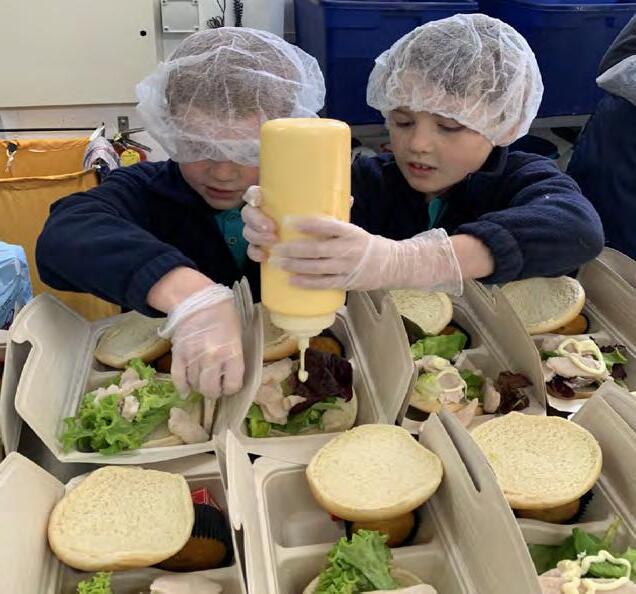
social enterprise opportunity for Tauranga,” said Bay Venues chief financial officer Adam Ellmers.
“Not only are we feeding our hungry tamariki, but as Bay Venues is a Council Controlled Organisation, any profits will also benefit the community by helping to pay for

the cost of running our community facilities.”
This means that during this time of Covid-19 uncertainty, Bay Venues can keep entry prices affordable at their community pools, centres, and halls, so they can be enjoyed by everyone in the community.


Our commitment to excellence, competitive costings and the ability to maintain better control of our projects is why property developers and commercial building architects return to the team at Marra again and again.
Embracing all areas of commercial and industrial construction, our team brings a wealth of technical and practical knowledge and experience to each and every project.
We don’t just build buildings, because anyone can do that. We grow investments

QUEST APARTMENTS


Looking to get your project off the ground?
Let’s discuss how Marra can take your project from concept to a quality investment.
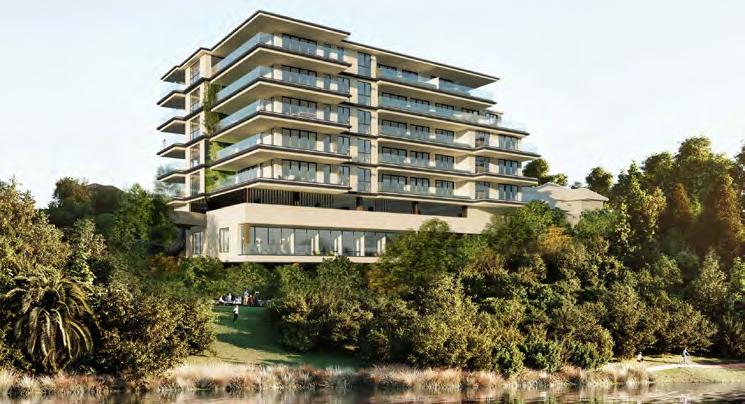

As the housing crisis continues to bite, in this edition we are spotlighting the rapidly emerging, and relatively recent phenomenon of apartment living for Kiwis.
By ALAN NEBEN
Throughout the Bay of Plenty, as in many metropolitan areas throughout the country, more homeowners are electing to avoid the downsides associated with the traditional quarter acre dream, instead opting to buy and live in apartments.
Cross-party consensus in Wellington has seen recent legislative initiatives allowing more intensive urban development.
This controversial move in response to the housing crisis marks a significant change in thinking – some argue it is misguided, ill-conceived and even unnecessary.
The regulatory changes underline the urgency for more flexible housing options. The New Zealand public, irrespective of political persuasion, is clearly signalling shortages in the housing stock must be urgently addressed.
During the last year Bay of Plenty Business News has featured several significant new apartment developments across the region.
According to Bayleys and EVES Realty Bay of Plenty chief executive officer Heath Young, “Gone are the days of a flat and an apartment being thought of as being the same. Today’s inner-city dwellers want luxury and low to no maintaince. They want to be near bus or train stations or within “scooter” range of cafes and bars and place of work, they want to be able to not have to use their car. The whole “live, work, play” dream is becoming a reality,” he observes.
In February 2021 we wrote about the Luxridge luxury apartment complex in central Tauranga.
According to Luxridge’s Kelly Cotter, “As developers, we are seeing a gradual shift in the market particularly in Tauranga where the local market is definitely favouring more high density living – this is evident in the number of enquiries, off the plans sales and the number of apartment blocks currently in the early stages of planning in the Tauranga CBD and surrounding areas.”
“The way people live their lives

has changed over recent times and has been somewhat compounded by Covid 19.
“A large portion of the population no longer desire the Kiwi quarter acre section, want low maintenance living and potentially the space for the ability to comfortably work from home,” he says.
“There are numerous risks and challenges facing developers however with careful planning and management we are able to mitigate the risk of these challenges.”
“All signs are indicating that the market will remain strong for 2022 and beyond, we expect sales will slow in off the plan developments as banks and funding institutions get their heads around the CCCFA requirements and adjust processing times accordingly,” he said.
“We understand there are a number of other developments coming to market shortly, this is an indication that developers are confident that a buoyant market will remain for the short to medium term.“
When pressed on the challenges facing apartment developers and buyers, Heath Young suggests that for developers it will be development costs, the cost of land, the costs councils impose and, right now, the dis-
ruption to the construction industry supply chain, due to Covid.
“For buyers it will be the changes to lending criteria and the unknown added costs as supply chain and cost overruns for developers get passed on to buyers,” he says.
In January 2022 we featured another significant Tauranga CBD apartment development Elizabeth Towers. Game changers some have said, likely to change the life and culture of central city Tauranga.
The central Tauranga apartment boom looks to continue unabated. Form’s completion of Latitude Residences, a six-level apartment building to downtown Tauranga was a significant step in the City’s march toward opening up to more luxury apartments.
Other significant apartment developments of note are spread across the region and promise to provide some limited respite to the Bay’s housing crisis; Readers may recall November’s Bay of Plenty Business News in which we explored the housing challenges in a front-page feature story entitled, “The Bay grapples with critical housing shortage – urgent action required.”
In March 2021 we featured Black and Orange Property’s Vantage lux-
Bayleys and EVES Realty BOP CEO Heath Young suggests typical apartment buyers fall into categories:
• Those who can’t afford the kiwi bach: so, buy an apartment at their favourite holiday hot spot.
• The empty nester: the kids have left home and the parents don’t want the big house and do want to enjoy life more, so the idea of a beautiful apartment is appealing.
• The busy people: don’t want the hassle of grounds to maintain, just want to enjoy life and the benefits of a lock and leave.
ury apartment complex, described as a premium mixed-use, seven storey development in Cameron Road Tauranga.
Of course, not all apartment developments are luxury options, and many others brand themselves as ‘affordable housing’.
We recently spoke to Williams Corporation managing director Matthew Horncastle. Williams Corporation is developing a significant Cameron Road Tauranga project consisting of one- and two-bedroom townhouses.
According to Matthew, “Homes across NZ are becoming smaller to remain affordable for purchasers. There is such interest in apartments here now because they are low maintenance and affordable.”
He warns however that there are still challenges with consenting and delivery, and he points to those as being the reasons you require an experienced builder.
What does he anticipate will happen in 2022 and beyond? “Smaller, low maintenance homes will become more common,” he predicts.
Within the Bay of Plenty, the surge in apartment development is not limited solely to Tauranga – focus in Whakatane has recently been on
• The travellers: people who have sold the “big house” and use the money to buy say an apartment here and another in another city or country to run away too during winter.
• The investor: this is a different type of buyer; this is someone looking for cashflow and capital gain.
• The mum and dad: wanting somewhere safe to put their kids while they are at Uni. As urban residential property becomes more expensive and further out from the centre and traffic worsens, the idea of “apartment living” oozes lifestyle and freedom.
plans announced to build an apartment complex at a former supermarket site in Kopeopeo with Kāinga Ora in charge of the development.
In central Whakatane, the site of the proposed Wairere Apartments development continues to be of interest to locals.
Rotorua Economic Development reported in 2021 they were eying inner-city carparks for redevelopment as apartments as part of their innercity apartments action plan.
Heath Young believes there will be some pressure and even some pain, caused by supply chain and cost overruns.
He says, “Strong developers will manage it, but others may falter as we saw during the GFC. However, after the disruption of Covid dissipates, apartment sales as with other residential sales, will recover.
“Longer term, apartments are a growing part of our city’s fabric. We only need to look at Wellington and Auckland or across the ditch to see what will happen here in time.”
Despite consenting hold-ups, labour shortfalls and supply chain delays, the growth in apartment developments looks set to continue at a pace into the future. The question remains however, “Is it fast enough?”
Some Bay locals and visitors have been caught out by the Tauranga commissioners’ decision to go ahead with long delayed major road works in recent months. The resulting traffic confusion has focused extra attention on Farmers’ major investment in the CBD with its $200 million investment in its new headquarters in the city.
ABy DAVID PORTER
t peak times more than 500 contractors have been involved in the build, injecting significant economic benefit into the local community. Once the building is complete, it will effectively double the residential population in the CBD. However, a successful end is in sight. The project – which opened the doors to its retail section in late February – includes a significant residential component, made up of 23
luxury townhouses and 97 high-end apartments across two towers.
These all brought together by a spectacular swimming, gym, green space, and recreational podium area known as the Sky Garden. They will be available for purchase in the first quarter of this year. For pre-sale information people should register their interest on the website www.elizabethtowers.co.nz.
The opening of the retail spaces at Thirty Eight Elizabeth in late February, which began construction in

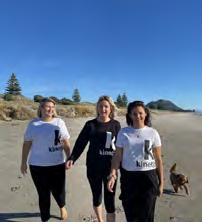
2018, marked the start of a new chapter for the CBD. Just over 7000sqm of the 8000 sqm retail offering on the ground and level has now opened, including a state-of-the-art Farmers store, and Whitcoulls and Pascoesalso located on the ground floor entrance on the corner of Elizabeth Street and Devonport Road.
These brands are all part of the James Pascoe Group, which is also behind the development under the name of Elizabeth Properties Limited.





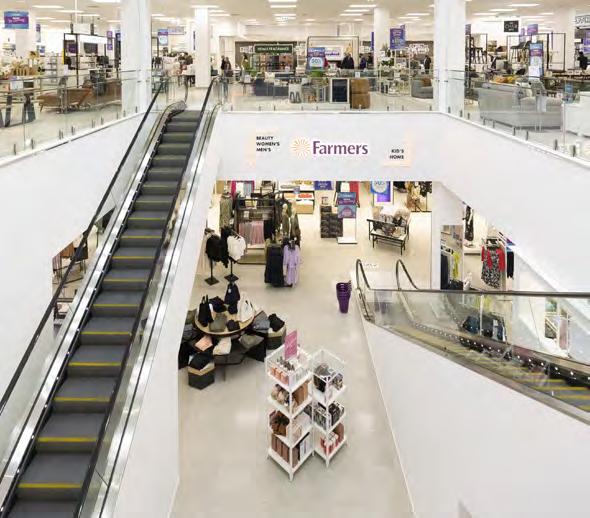



“This entrance on the corner of Elizabeth Street and Devonport Road is the gateway to a new fashion and beauty retail experience, one that Tauranga has been waiting for to bring revitalisation to the CBD,” said Thirty Eight Elizabeth project manager Brett Nicholls.
“The entire development provides a grand gateway to the CBD, one that celebrates the history and significance of the site for the CBD.” The Farmers store has been designed and fitted out following on from the brand’s success at Sylvia Park and 277 in Newmarket, Auckland.
“This is a step above,” said Nicholls. “We always take the shopping experience to the next level when we open a new store.”
Subway will also be open again on site, on Elizabeth Street close to the laneway that leads to First Avenue.
A morning karakia (blessing) and ribbon cutting has been held on site to mark the official opening. A small group of kaumātua led by Tamati Tata, as well as a limited number of Tauranga City Council commissioners, Farmers’ managers, and building contractors gathered to celebrate. The smallness of the event reflected the government’s new traffic light regulations.
“Ngāi Tamarāwaho, the Ngāti Ranginui iwi hapū, whose people traditionally lived in the area, hold the mana whenua for the site, which is at the heart of its rohe,” said kaumātua Buddy Mikaere.
“Ngāi Tamarāwaho has supported this project from the outset and considers that the redevelopment fits with its aspirations for the city centre.”
Nicholls said Farmers’ acknowledged Ngāi Tamarāwaho’s ancestral ties to the site and were working closely with representatives to include design features that reflect this history. The Farmers corner had a long history of retail stretching back to its roots as the Devon mall in the early 1970s, he said.
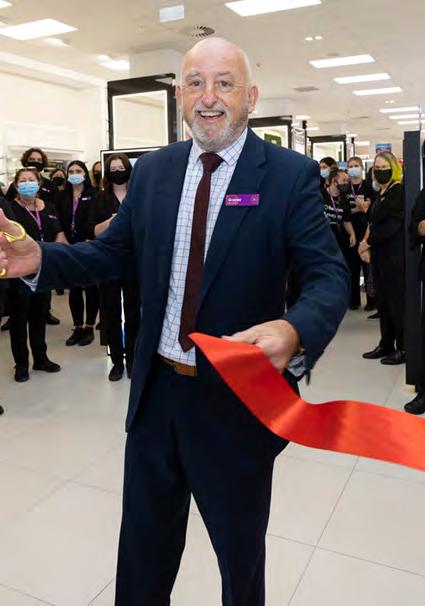
While the timing of the grand opening is still being determined due to the Covid restrictions and shutdowns of last year, it is expected to take place in the first half of 2022.
“We want the fullness and potential of the entire development to be open and enjoyed as soon as possible,” said Nicholls.
“That is why we have put extra resources into the build from the start to bring it to fruition in an ambitious timeframe. We are not far behind schedule considering the number of Covid setbacks our amazing team has had to overcome.
“It is a homecoming for Farmers, which has strong historic ties to the site. We are glad to be ‘home’. “Farmers at The Crossing and Bayfair will remain host to home furnishings, manchester, and homewares. Farmers at Thirty Eight Elizabeth will showcase the best of fashion and beauty.”
“It’s an exciting idea that has caught on in shopping areas overseas,” Nicholls said. “People are looking for a whole new experience when they go out. They’re enjoying a quality meal at their shopping destination, rather than eating and shopping separately.”

It’s hard to believe we’re already approaching the end of the financial year. With the whirlwind of the past couple of years and all the changes Covid-19 had brought about, many small business owners have been under increased pressure and stress.
We’re heading into the third year of the Covid pandemic, and the Bay of Plenty had their first move into the red traffic light setting with Omicron cases spiking in the community.
They’re navigating additional requirements, such as vaccine passports and capacity restrictions due to staff being required to isolate, all while juggling the extra workload the end of the financial year brings.
It’s therefore no surprise that many business owners I have spoken to are feeling the
additional weight now more than ever. After all, they’re working more, but the business is earning less.
Even at the best of times, small business owners are familiar with the challenges of the intermixing of work and life. When we’re overwhelmed, this separation is usually the first thing to fall away.
Don’t forget about wellbeing
But as we head into the eye of the storm, try not to forget
Give yourself permission to switch off at the end of the day. It’s valuable to have clear distinctions between when you’re working and when you’re not.
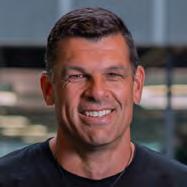
> BY CRAIG HUDSON
Craig Hudson is Xero’s managing director for New Zealand and the Pacific Islands.
about your team’s and your own wellbeing.
A couple of helpful tips I’ve learned over the years to help switch off is to set up separate work spaces and leisure spaces if you work from home, which makes a world of difference when it comes to clocking off.
Other things include turning off notifications on your email app during leisure hours and scheduling time for things in life you enjoy like, a hobby or spending time with your whānau – making an effort to be mindfully present during these times.
Give yourself permission to switch off at the end of the day.
It’s valuable to have clear distinctions between when you’re working and when you’re not.
Once you’ve set these boundaries for yourself, communicate them with your team.
Fostering a culture of open communication, where people feel safe to say they’re not coping, allows you to work together towards a solution.
free and 100 percent confidential wellbeing counselling for employees and their families – whether it’s for face-to-face, over the phone or online.
Setting and managing healthy boundaries can reduce stress, improve mental wellbeing and ultimately allow you and your employees to bring your best selves to work. Ultimately, 2022 is going to be a challenging year for us
To feature in New Appointments email us at new.appointments@bopbusinessnews.co.nz
Bay-wide, major organisations are holding their own against Covid-19 and new variant Omicron, with many of the region’s major groups and companies pushing ahead with new appointments. Please contact us if your organisation has personnel changes you would like to share.
Tuihana Walker Strategic communications agency, The Shine Collective, welcomes Tuihana Walker (Ngāti Ranginui, Ngai Te Rangi, Ngāti Pukenga, Te Arawa) as Senior Engagement Consultant | Kaitohu Matua Tūhono to its expanding team.

Tui has more than a decade working across the education and creative industries, refining her skills in PR, UX and digital communications.
She has worked closely with hapū and iwi, supporting kaupapa Māori initiatives.
A fluent te reo Māori speaker with a keen interest in bicultural communication, her skills and expertise are a valuable addition to the Shine team.
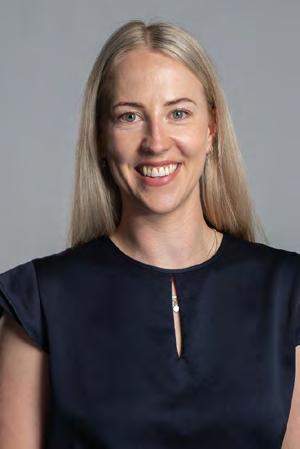
Joanna Hall has recently been appointed Senior Policy Advisor within the Employers and Manufacturers Association’s (EMA) Advocacy team in the critical portfolios of Immigration, Skills and Training, touching on many areas of interest for NZ Businesses. Before joining the Advocacy team Joanna spent the last four years as Executive Officer of ExportNZ BOP and the EMA’s BOP Regional Manager. Remaining Tauranga based, Joanna brings a strong local and regional focus to the EMA’s Advocacy team as well as commenting on national and local issues. She’ll continue to work with and further develop her strong relationships with the EMA’s business members and partners.

Hayley Nelson joined Craigs Investment Partners in January 2022 with over 22 years’ experience in the financial services industry.
Prior to Craigs, Hayley has worked directly with clients through relationship management and private banking, transitioning to management, people leadership and strategic roles in the banking industry with both ASB and BNZ.
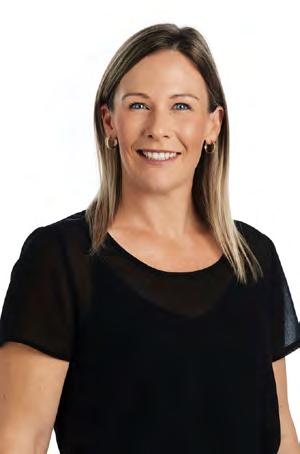
As Area Manager, Hayley is responsible for leading our Craigs Investment advisers in our Tauranga and Hamilton offices to deliver the best possible client outcomes while managing the operations of these offices. She actively works on growing the Craigs brand positively in the local community while leading advisers’ development and growth.
For more information on Craigs Investment Partners visit craigsip.com
Sometimes the hardest thing in business is to just say no, but it can be the best thing to say.

> BY NICK KERR
Nick Kerr is a Business Advisor at NJK Advisory Ltd.
He is also director of International Private Investigations Ltd. Nick can be reached at nick@nzipi.com
uring the Global Financial Crisis (GFC) in 2008 I was a young, eager-to-please credit consultant answering every call and saying “yes I will help” to every caller.
To put this in perspective some days I received over 15 inbound calls from individual callers, so every month I had 300 extra things to do compared to the month before.
Some of these collections or mediations took three months to complete. I had up to 1,000 things on the boil at any one point meaning that I had six separate things to deal with every hour, 12 hours a day, every working day of the month.
Before long I was burned
out, exhausted and I wanted to quit altogether.
I worked out quickly that I could give quality or quantity,
Instead of staying “no, I don’t want to,” I said, “that’s not the kind of issue I specialise in.”
but never both so I started to set limits of new clients I would take on and put criteria on the kind of cases I would take on.
So instead of saying “no I’m too busy” or “no I don’t want to,” I said “that’s not the kind of issue I specialise in”.
Not only did it lessen my workload, it defined me as a specialist who delivered quality results to a select group of clients rather than a provider of mediocre service.
This has served me well ever since and has led me to have a reputation as a sought-after consultant who doesn’t deal with just anyone.
How debts can arise
I was called in last month to mediate a large debt in the construction industry. The other party was a painting contractor in Rotorua.

After tracking him down, which was not easy, we sat down and had a chat about how the debt arose.
According to the painter, he had taken on too much work and he was unable to get all of the work done with the team he had.
Not wanting to disappoint his clients, he took on some subcontractors who he didn’t know very well. However, after a few jobs, the client complaints starting coining in, jobs
were not finished, work was substandard and clients were being asked to pay in cash at the end of the job. Which of course went right into the subcontractors’ pocket.
After a month or so the painter asked around about the subcontractors with his industry friends and it turned out that the main subcontractor had a history of methamphetamine abuse, which led to acts of dishonesty and multiple jobs left unfinished.
The upshot was that instead of the painter having a few clients disappointed that they could not utilise his service, he ended up with clients who were so dissatisfied they took him to court claiming thousands of dollars in damages which has left his reputation in tatters.
Always remember that having said no is a lot easier than saying sorry, if it ends up in court.
Just a thought.
Amongst our standard questions for potential franchisee entrepreneurs is, who’s going to be involved in the business with you? Very often the answer is a spouse, sometimes children, or a brother or sister. Is this a good idea, and what do you need to consider if you are looking at this very proposition.
For some people this would sound like a great idea, but others may shudder the thought.
Is it a good idea? The statistics are mixed. There are many very successful family businesses including both franchisees and franchisors. Unfortunately, there are also a great number that result in failure of the business, and or marriage or family breakdowns.
I have seen from experience several common traits amongst family franchised business that do well. So some of the questions you need to answer are:
Why are you choosing to go into business with the family?
To start with, let’s look at the contradiction of data. Research suggests that it’s not necessarily the family business that drives success or failure, but the motivation. If the key driver is to work with family, or provide employment for your kids, the success rates can be dubious.
If the reason is to build an asset or legacy for the family, do something you love or create work-life balance than the success rates tend to go up.
Have you worked together before?

> BY NATHAN BONNEY
Nathan Bonney is a director of Iridium Partners. He can be reached at nathan@iridium.net.nz or 0275-393-022
You really need to answer these questions before you go any further.
In your own business there is no “at the end of the day” –issues at work become issues at home, so you really need to be aligned and be able to work together.
What are your skills sets, who’s going to do what?
The most successful family business units I have seen
How are you going to fund it?
This is a not so small question, and again one that you need total alignment on. This is the case particularly if there is a decision involving selling an asset like a family home or both parties leaving paid employment – especially if one of them is doing so with any hesitation.
We will often suggest that even if the long-term plan is for partners, or multiple family members to be in the franchise, that they start with just one. This can provide some
In your own business there is no “at the end of the day” – issues at work become issues at home, so you really need to be aligned and be able to work together.”
define the roles that each member will take, hopefully complementing and supporting each other in the process. Using a retail business example, if one family member has great customer service skills and experience and the other perhaps administration, the two fit together very nicely, one sells, the other looks after the administration.
From both my professional and personal life I can tell you, this is a biggie. Have you worked together, who’s going to be the boss, who’s going to do what? How is that going to work?
continuity of both lifestyle and income and can reduce quite a bit of stress.
How are you going to manage the other parts of your lives?
Is having multiple family members in the franchised business going to improve your work-life balance or

make it worse? How are you going to manage the other things in your life you need or want to do?
The key thing here I would suggest is assessing the type of business or industry and its compatibility with your lifestyle.
If you have young children then an all day-night hospitality business may not suit, but a 7am to 5pm café or retail business may.
In the latter, a small family
unit could provide good coverage for opening hours and the ability to drop off and pick up kids everyday.
Is it for you?
There are so many reasons why family franchises make sense including; building a family asset, having multiple people in the business that have a stake, or “skin in the game” and some more altruistic ones like family businesses tend to
have higher levels of community and social engagement. They often also deliver higher levels of personal satisfaction and provide the family the ability to manage their own work life balance. I cannot answer the question of whether it’s good for you. But if you can positively answer my questions above then you’re well on the way of making the correct decision for you.
The Farm Forestry Association claims anthropologist Dame Anne Salmond’s recently publicised view, that planting native forests offers the best solution to the climate crisis, is misinformed and misleading.
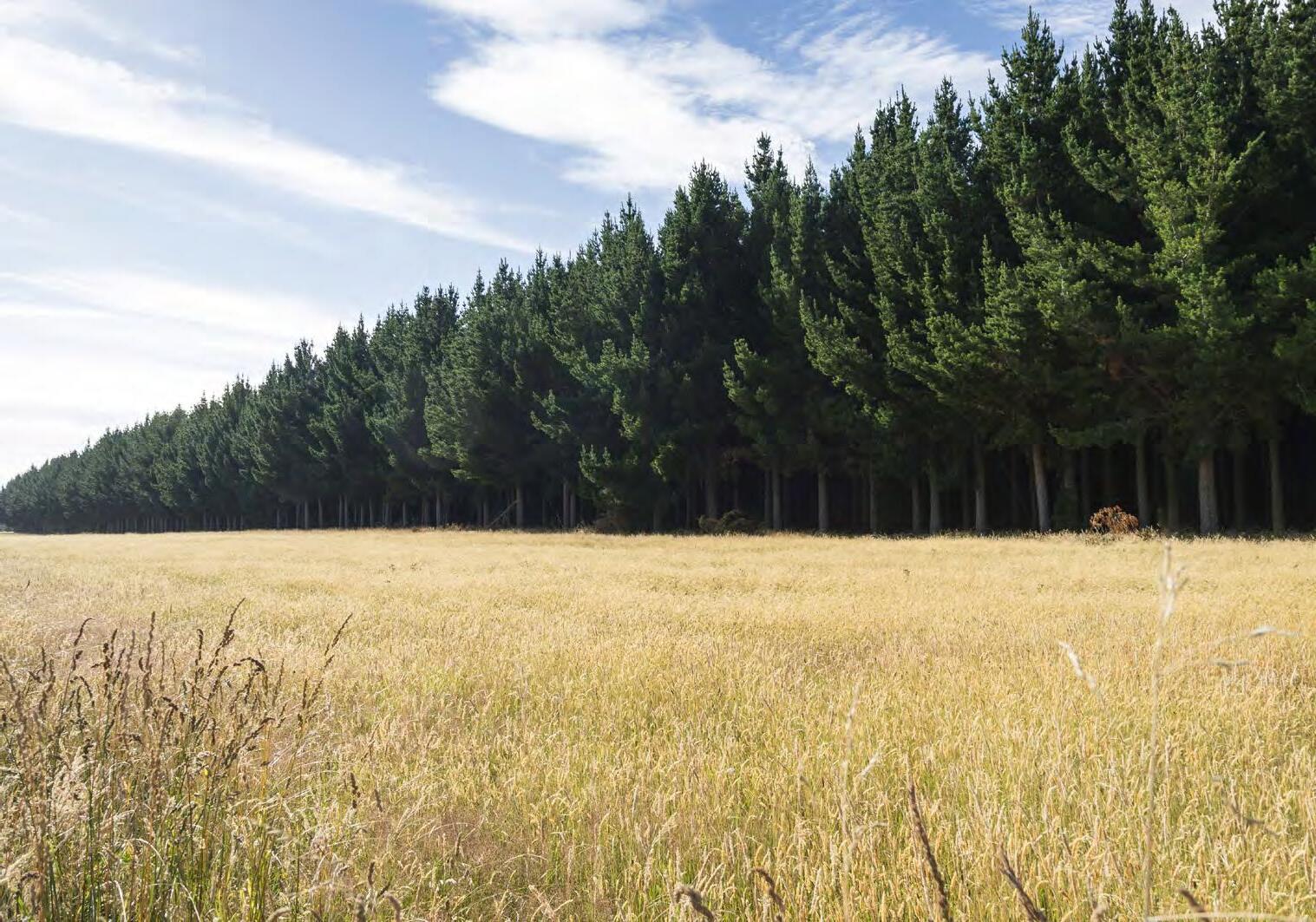
Association president Graham West said the overwhelming evidence was that instead, using managed exotic forests as carbon sequestration off-sets will provide the only currently affordable and viable solution for New Zealand to reach its 2030 and 2050 greenhouse gas reduction targets.
“Dame Anne doesn’t offer a timeline for her native tree solution,” said West. “But unfortunately the time horizon is absolutely crucial.
“We do not have 100 or 200 years to spare in which to wait for native trees to lock up appreciable volumes of carbon. The climate change issues are far more urgent
than that.”
“Offsetting may not be internationally accepted by all, but as we all get more desperate, the solutions will become more pragmatic.”
West said the call for a ‘nature based’ solution should not preclude exotics, which are natural in a different part of the globe.
Relying on exotics
“We comfortably rely on many exotics, including pasture species, farm animals, kiwifruit and other introduced fruit and vegetables.
“So why not forests? Should we farm weka or kiwi as the only natural option for food production in New Zealand?
“Reserving the permanent carbon option for native forests is not supported by the science. We need to lock-up
a far greater land area and a vast government spend to establish these trees.” West asserted that on
We do not have 100 or 200 years to spare in which to wait for native trees to lock up appreciable volumes of carbon. The climate change issues are far more urgent than that.”
extra carbon dioxide in large reservoirs quickly. Choosing native species to plant will limit this severely, or require
average, a hectare of our native forest would take hundreds of years to sequester about 900 tonnes of carbon
dioxide and then stop adding any more. By comparison, many exotic tree species would store about twice that in 70 years and continue growing.
“There are hundreds of measurement plots in our exotic forest plantations that verify this. It’s too late to wait for a ‘natural’ solution or hope for a miracle cure for emissions. We need to quickly protect our primary sector market access, by reverting and managing about 400,000 hectares of our marginal land back into forest.”
West said that much of this resource was scattered through the landscape, often at the back of farms where
access precludes timber harvest.
“The real engine-room of the economy is the flat land that is accessible to machinery. In the short term we need to deflect concerns about animal emissions on this land by off-setting.”
New Zealand needed to show the world a land use change to offsetting was a necessary solution. The whole world could adopt to react to climate change within a timeframe that saved our economy and possibly human life, he said.
“We have the land, tree species, and the knowhow. Let’s implement an effective action plan that encourages world action”
A few weeks ago, Jacinda Ardern announced our borders will open soon. What great news. Let’s face it, the economy cannot sustain such an inflation hike and, as history shows, high inflation and too much credit in the market are pre-recession signs.

> BY VALERIE ROWE-MITCHELL
Accounting and other money matters with Valerie Rowe-Mitchell, owner of Emerald Business Advisers. Valerie can be reached on 07 579 5777 or valerie@emeraldbusiness.co.nz
nce the borders are open, there is the possibility for the economy to benefit from overseas funds. At least that’s what we hope for. Bring on October 2022, the new normal is just around the corner.
Being a business owner is not easy under normal circumstances, but the last two years were really testing.
If you are still in business, paying wages to your employees and making money to feed your family, I applaud you. There is a raft of skills we require to survive uncertainty and unprecedented events. You probably had to become innovative, hear what your customers want, learn how to serve a better product or service, and most importantly, give your clients the gift of attention and time. Benjamin Franklin said “In this world, nothing is certain except death and taxes”.
The reality is, if you are making money, you have to pay tax, but the question is
how to eradicate tax payment surprises.
Save for tax
You may have had a couple of occasions where your tax bill arrived two days before the due date and the money on your account was planned for wages and supplier bills. The instant response is “why did the accountant send
the day you start generating income to remember, that not all of it is yours, and tax bills grow with the increase in your revenue.
May I suggest setting up the following procedures to eliminate tax surprises.
It may be hard at the beginning, but I guarantee once your tax pool becomes bigger, you will feel a lot more in control.
1. Set up a separate bank
The best practice is from the day you start generating income to remember, that not all of it is yours, and tax bills grow with the increase in your revenue.
me this two days before the due date?” Fair call. And I will add this: “Why was I not advised last year to start saving for tax?”
The best practice is from

2. Transfer 25 percent of your Gross Revenue to your Tax account each month. Gross Revenue is the total funds you have collected from your customers.
account for your tax savings
3. Watch your Cashflow. To be sustainable a business must have a positive cashflow from operating activities. If your operating cashflow is negative, you are losing money and need to address your pricing, review marketing and analyse costs.
4. Anticipate your tax payments. Ask your accountant to prepare a schedule of tax payments for the upcoming 12 months, including PAYE, FBT, GST and Income tax, and put it on your wall.
Being in business today is challenging, but also an exhilarating venture. Remember, never in history were we able to advertise and reach customers in an instance and for a fraction of the cost. The technological progress truly opened entrepreneurial horizons and this is just the beginning. Keep up the great work and I hope to meet you one day and hear your story.
Tauranga City Commissioners, in a council meeting in late February, have agreed to consult with the community on cost options to create the new Civic Project Master Plan.
The first option is for a library/civic/whare (venue for council and community meetings, museum and exhibition space.
It includes the development of the waterfront reserve between Hamilton Street and Wharf Street, linking the harbour to the civic precinct via Masonic Park.
The second option includes a library and community hub and the civic whare.
The first option would cost $303.4 million and take six years while the second option would cost $126. 8 million and could take an estimated 14 years.
Staff recommended the first option as it could be completed in six years and carried out as a single stage project, according to programme director of civic redevelopment projects Mike Naude.
The second option would invoice individual builds carried out in silos. The advantage of option one was that the council would be able to consolidate the designers, labour and production costs, the meeting heard.
“It’s important we see this as a holistic campus plan being delivered rather than a large ongoing set of projects,” said Naude. “Making sure you don’t have a stop-go and have full continuation will certainly speed up delivery of the project,” he said.
Half of the cost is expected to be debt funded and financed through rates with the balance coming from the sale of non-core government assets, government grants and sponsorship. However, the funding needed was yet to be sourced.
Industrial logistics and warehousing businesses are hurtling towards the wider use of automation and it’s a hot topic in the property world with implications for warehouse and factory users, manufacturers – and landlords.
While it seems like a brave new world, the first industrial robot is believed to have been an assembly line robot installed in a General Motors automobile factory in New Jersey back in the early-1960s.
Bayleys’ national director industrial, Scott Campbell, says we need to acknowledge that the robots are amongst us and it’s inevitable that automation will redefine how businesses operate, and property must respond to the associated changed dynamics.
“We are going to face labour shortages in this country and business owners will be looking to plug the gaps,” he said.
“It’s the way the world’s heading in the quest for efficiencies, optimal productivity and cost-effectiveness.
“Smart technology is well-established in the States, where it is thought more than 70 percent of all new major warehouses have automation capability but proactive developers in New Zealand are still

getting their heads around the implications for new-build premises.”
Fully automated foresight required
Campbell says fully automated premises require significant forethought as often the racking needs to be built first and then the physical warehouse structure created around
that. “It requires a change in our thinking, and we need to consider many things, including – but not limited to – floor loadings, power requirements, lighting, cabling and access.
“Some buildings can be retrofitted to partially-automate operations, but this essentially comes down to what products we’re talking about and the core operational functions of individual businesses.
“Movements of boxes of biscuits and cartons of beer will have completely different ‘pick and pack’ requirements to a business that supplies small components or parts, for example.”
Automation can – and will – take many different forms depending on industry sector requirements, but all will lead to the minimising of human touchpoints.

At Bayleys, we believe relationships are what businesses are built on and how they succeed. We understand that to maximise the return on your property you need:
and
team today.
297 Te Puna Station Road is set to be developed as part of the planned Te Puna Business Park to support the region’s fast growing primary sector and strong economy in line with approvals set out by the Environment Court in 2005.
The site is to be developed by Te Puna Industrial Limited, a partnership of local investors and ContainerCo.
Te Puna Industrial spokesperson and ContainerCo managing director Ken Harris said now is the time to realise the vision of the former owners in 2004 to create a staged ‘Green’ business park in Te Puna Road Station to service the local rural sector and the Bay of Plenty economy over the next 5-15 years.
In 2005, the Environment Court approved a private plan change moving the zoning from rural to industrial to enable the creation of the Te Puna Business Park. Provisions of the plan change process include bespoke mitigation measures to ensure a lower level of impact and

adverse environmental effects on the surrounding area.
Since then there has been noticeable growth in commercial, industrial and residential development in the Te Puna area. There has also been investment in local infrastructure to better service the area including an upgrade of
the Te Puna Road-State Highway 2 roundabout and works have also begun on Stage 1 of the new 6.8km four-lane motorway connecting SH29 Takitimu Drive through to SH2 west of Te Puna.
“The business park concept was initiated 18 years ago to meet growth in sectors such as Kiwifruit across Bay of Plenty and its now more important than ever as exports have increased and as has growth at the Port of Tauranga, which is now the largest in New Zealand,” Mr Harris said.
Resource consents have been sought to give effect to the Te Puna Business Park industrial zoning provisions applying to the site. All tenants including ContainerCo will comply with the consent requirements including noise, visual and landscape mitiga-
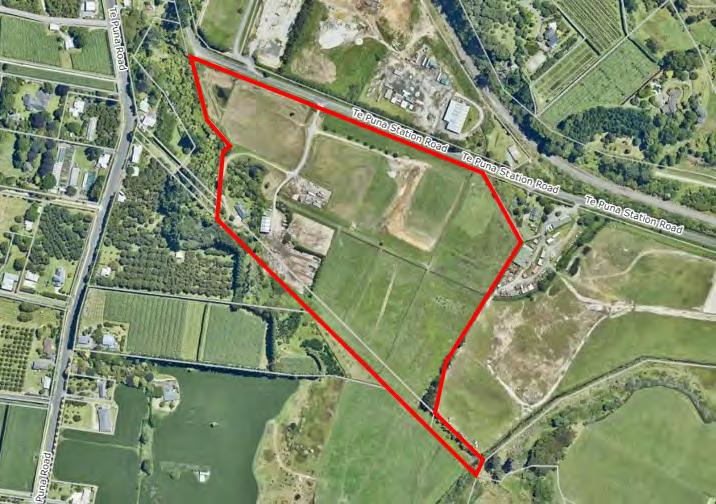
tion, building heights, stormwater and other environmental requirements.
The predominant use of the development will be industrial in nature in accordance with specific use types permitted at the Te Puna Business Park. The long-term goal is to accommodate businesses such as specialised workshops, machinery outlets, and offices predominantly focused on supporting the rural sector and related exports, incorporating ContainerCo operations.
It is proposed to develop the site in three stages. Stage 1 will see extensive landscaping and environmental enhancement work such as bunds and setbacks from road frontage
as well as ponds and other features that enhance both enhance environmental outcomes and visual appeal and cultural values.
“We expect that landscaping work and water management on site will enhance the surrounding area and be based on the re-establishment of indigenous vegetation and indigenous fauna. Our goal in this regard is to support the general, social and cultural wellbeing of the community and the environment.”
Mr Harris says moving low intensity specialist support businesses to Te Puna enables ContainerCo to better support local produce exporters and capacity issues at its Mount
What is the land zoned as?
The land is zoned Industrial, within a specific Te Puna Business Park Structure Plan area which is subject to bespoke visual amenity, landscape and character, stormwater and traffic mitigation measures relative to the surrounding context.
This is to achieve a lower level of impact and ensure adverse environmental effects are avoided, remedied or mitigated.
There are also two narrow parcels at the southern boundary of the site (1.06ha in total) zoned Rural.
The wider Te Puna Business Park industrial area comprises approximately 23ha of land on the southern side of Te Puna Station Road, and 7.2ha of land on the northern side. Surrounding land beyond the business park is zoned Rural.
All tenants will comply with the consent requirements including noise, visual and landscape mitigation, building heights, stormwater and other environmental requirements.
Why is the business park being developed now?
We believe this development will directly and indirectly support of the region’s exporters.
The vision for a business park was mooted in the early 2000s and the former owners of the land successfully gained approval for it in 2005.
There has been significant growth in the region’s primary sector which has led to Port of Tauranga becoming New Zealand’s largest port.
Since 2005, there has been noticeable growth in commercial, industrial and residential development in the Te Puna area. There has also been investment in local infrastructure to better service the area including an upgrade of the Te Puna-State Highway 2 roundabout and works have begun on the stage 1 of the new 6.8km fourlane road connecting SH29 Takitimu Drive through to SH2 west of Te Puna.
What is the size of the development?
The total site area 12.16ha with a total of 11.96ha of the site is proposed to be utilised for industrial purposes, with associated mitigation, across the three planned stages.
When will the land be developed?
We will be taking a staged approach to develop the land.
Stage 1, commencing in the first half of 2022 comprises of seven lease areas which are proposed to accommodate yard-based (as opposed to warehouse/building-based) industrial activities and extensive landscaping and environmental enhancement work such as bunds and setbacks from road frontage as well as ponds and other features that enhance both enhance environmental outcomes and visual appeal and cultural values.
Stages 2 and 3 are deferred for future consideration and do not form part of current resource consent applications.
What Consultation and Engagement has taken place?
Consultation and engagement has been undertaken with hapū and iwi with a registered interest in the area recognising the interest of mana whenua and tangata whenua groups.
In addition to this consultation has also taken place with infrastructure providers, consenting authorities, and Heritage New Zealand Pouhere Taonga at pre-application stage.
What type of industrial tenant will be at the business park?
Permitted activities at the Te Puna Business Park include: industrial (manufacturing, processing, packaging or dismantling activities, engineering workshops etc.)
• storage and warehousing
• building and construction wholesalers (including ancillary retail)
• depots
• commercial services
• medical and scientific facilities
• retail outlets for primary produce with a maximum floor area of 100m2
• garden centres and plant nurseries (including ancillary cafes not exceeding a maximum floor area of 100m2)
• farm vehicle and machinery sales Stage 1 seeks to accommodate predominantly yard-based tenants in accordance with the permitted uses above.
What is the Te Puna Business Park Structure Plan?
The Structure Plan divides development within the park into four stages. The structure plan requires development to progress in the nominated sequence of stages, with specific landscaping, stormwater and roading mitigation requirements in advance of any industrial development to be met, secured by corresponding rules of the District Plan.
The structure plan also requires the delivery of a prescribed landscaping and stormwater management strategy and integrated acoustic mitigation measures. This includes periphery and roadscape planting, and overland flow path protection within the business park.
What hours will ContainerCo operate?
Hours of operation will be a maximum of 7am -6.30pm, Monday to Saturday.
What impact will the development have on traffic and surrounding road infrastructure?
The traffic impacts in terms of congestion and efficient, and have been comprehensively considered.
We expect to generate a maximum of 657 vehicle movements (in and out) of the site per day, 12% of which would be heavy vehicles.
The entrance will be upgraded to an appropriate intersection, specifically designed to the road speed and geometry for safety and efficiency.
What activities will ContainerCo operate from the park?
The site will enable ContainerCo to relocate non-intense operations, many of which do not need to be near a port such as a base for container refurbishment, and hire and sales teams.
ContainerCo will hold a small supply of containers (up to 100 containers) for kiwifruit growers and packers to cope with summer harvest demands, as well as provide a range of supply chain services including vanning and devanning. In the long term the site may well serve as a depot for our EV container shuttle fleet including fast charging points.
This site won’t be a large depot or terminal but we envisage storing containers up to three-high, which is approximately 7.8m for standard height containers (2.6m height) and 8.7m for tall containers (2.9m each). This is generally consistent with the height of buildings anticipated in the Te Puna Business Park, which is 9m as a permitted activity. Screening is proposed around the periphery of the site which will mitigate visual impacts from stored containers.
The other component of use will be for container refurbishment – an area of about 30m x 30m as part of Lease 2. This area would be flanked by four 40-foot containers (stacked two-high at sides supporting a covered roof area), and includes specific screening and drainage design measures to ensure the minimise visibility and noise from refurbishment activities, and to ensure water in the area is rigorously treated.
We are also leading the way in introducing EV (electrical vehicles)
Maunganui sites.
“The site will provide a base for our container refurbishment and hire and sales teams”.
“Large numbers of containers are not envisaged but we expect to hold a small supply of containers for kiwifruit growers and packers to cope with summer harvest demands and in the long-term the site may well serve as a depot for our Electric Vehicle (EV) container shuttle fleet including fast charging points”.
ContainerCo is a Tauranga based business employing a culturally diverse workforce of around 100 staff in the city across sites at Mount Maunganui and Sulphur Point.
to our truck fleet and we see the benefit of having onsite fast charge facilities at the site for future use.
What other activity will be generated due to ContainerCo being on the site?
Single and double truck-and-trailer vehicles will access the site in picking up and dropping off containers, in addition to light vehicles. No lighting structures are proposed. ContainerCo will comply with the noise limits applicable to the industrial land and the expected noise generated would not be unreasonable.
What are some of the other benefits to Bay of Plenty businesses?
The business park concept was initiated 18 years ago to meet growth in sectors such as Kiwifruit across Bay of Plenty and its now more important than ever as exports have increased and so has growth at the Port of Tauranga, which is now the largest in New Zealand.
It also enables ContainerCo to free up capacity at the core Mt Maunganui and Sulphur Point facilities and assist exporters to match pack timelines with shipping time lines.
What Noise Levels will be generated from the site?
Noise levels will comply with both at-site generation, and as receiving at-dwelling, District Plan levels. Also no lighting within the development is proposed.
Will the development have an impact on services?
No, proposed stormwater and waste-water networks will be self-sufficient. Water supply, electricity and communications infrastructure connections can be feasibly made and serviced by the adjacent/supplied networks in the area.
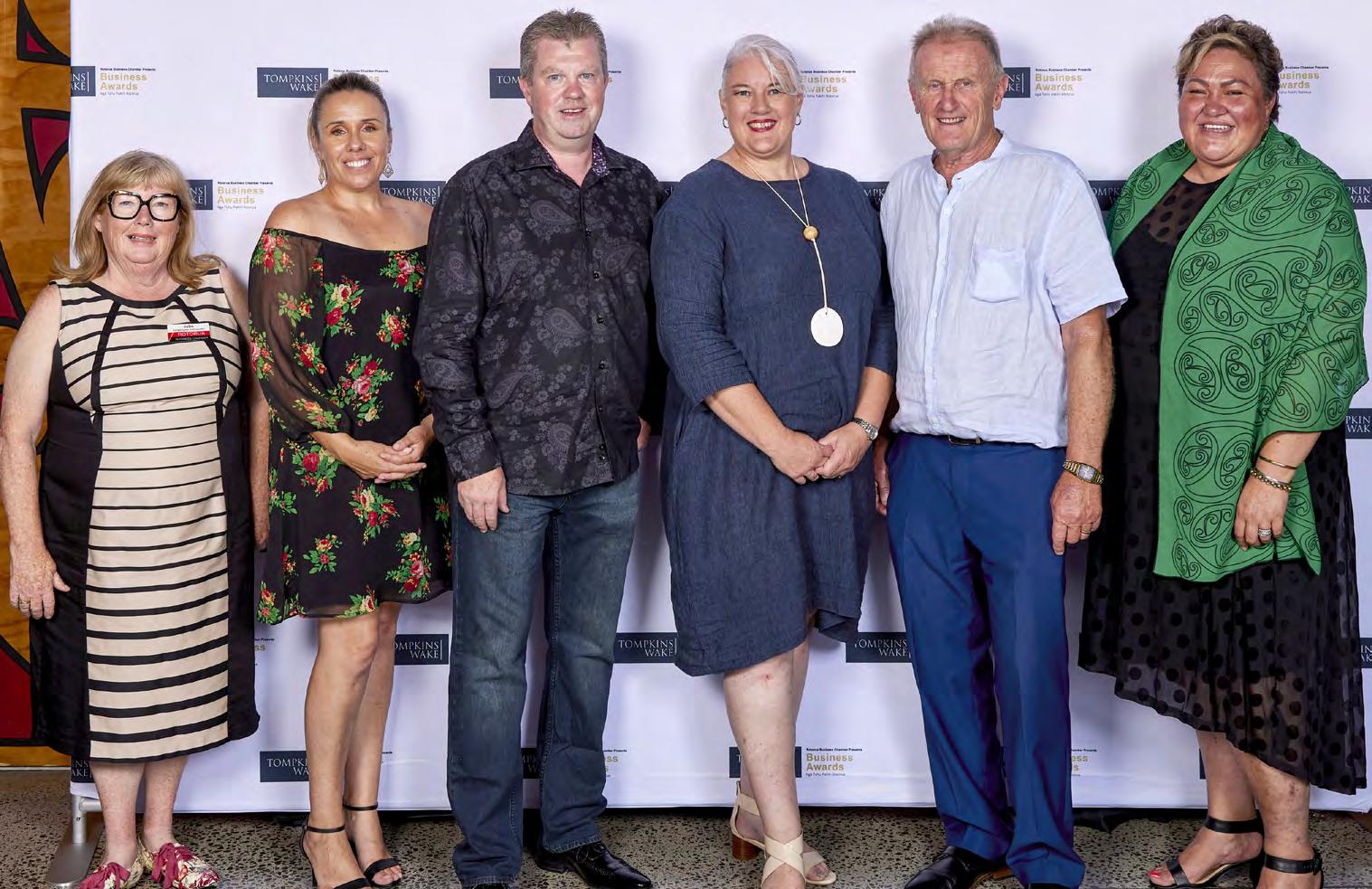
It was an evening of glitz and glamour with a large virtual audience comprising of 53 finalists, 22 sponsors, 29 judges, staff, plus the public. A terrific turnout to celebrate the excellence of the Rotorua business community.
Tompkins Wake warmly congratulates the 2021 winners and acknowledges every business that entered the awards. We commend you all for having the courage to put yourself forward and recognise your success.
While it’s not clear how many more months of disruption we have ahead, the resilience and strength shown by the Rotorua business community is truly inspiring and represents everything that makes doing business in the region so special.
Toi Ohomai Institute of Technology: Creative Arts & Design Award – Redwoods
Treewalk & Nightlights
Scion: Innovation & Technology Award – Salt + Tonic
Deloitte: Hospitality & Retail Award – McLeods Booksellers Ltd
The Shine Collective: Manaakitanga Tourism Award –Rotorua Canopy Tours
Pukeroa Oruawhata Holdings: Primary Manufacturing & Building Award – BOP Plumbing & Gas
Holland Beckett: Professional Services Award – The Shine Collective
Rotorua Economic Development: Kaitiakitanga Environmental Sustainability & Climate Change Award –Waimangu Volcanic Valley ACC: Workplace Safety Award –Hayes International EMA: Employer of the Year Award – InfraCore Ltd Ministry of Social Development: Not for Profit & Social Enterprise Award – Ka Pai Kai
Rotorua Charitable Trust
BNZ: Bilingual Business Award – Rotoiti 15 Trust
NZME: People’s Choice Award – Ka Pai Kai Rotorua Charitable Trust
Rotorua Lakes Council: Outstanding Contribution to Rotorua Award – Rotorua Multicultural Council
Red Stag: Business Person of the Year Award – Colin Sargison
Tompkins Wake: Supreme Winner Award – Redwoods
Treewalk & Nightlights

SUPREME WINNER OF THE TOMPKINS WAKE ROTORUA BUSINESS AWARDS 2021
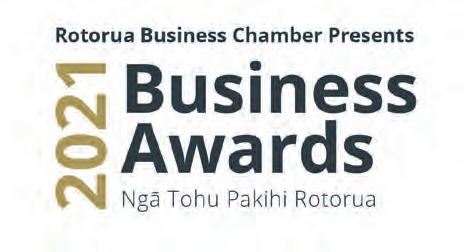











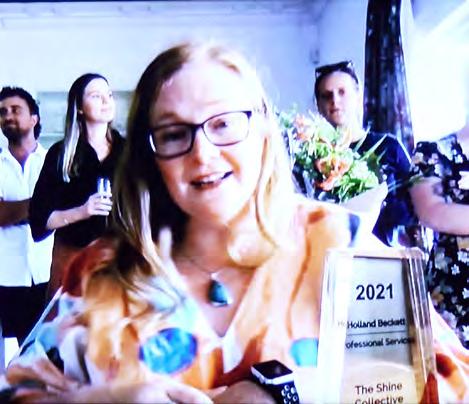
1 6 11 13 4 9 5 10 3 8 12 2 7 14 15

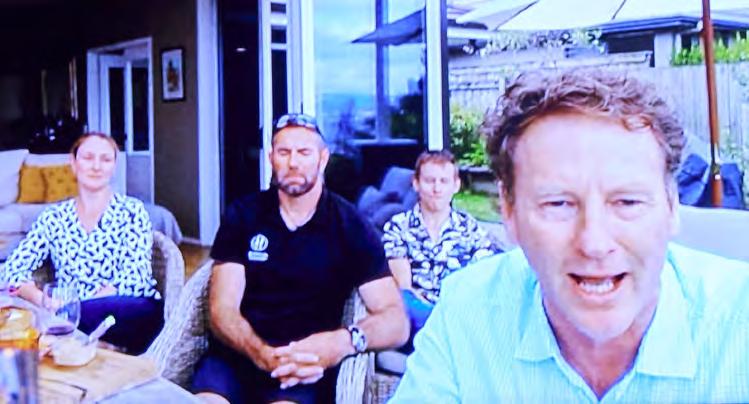

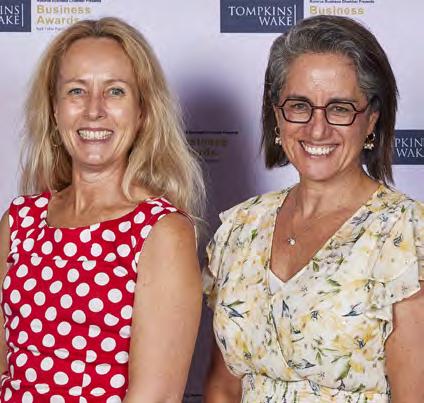
Once upon a time, long, long ago I had a mailing address – like a mailbox, not an Inbox – and my lawyer knew where my investments were held (well most of them, except for my TAB account, but let’s keep that between us).
Today I have a twitter handle and even I don’t know my bitcoin wallet’s security code. Seriously, if I pass away tomorrow, will some pimply-faced North Korean kid somehow end up owning my identity and all my crypto assets?
One thing is certain, my 81year old lawyer, Steady Eddie – despite his disturbingly shaky hands he’s by all accounts the safest conveyancer in the business – sure won’t have any chance of hacking my ex-life.
There is a serious lesson here for all of those intending to one day be dead: Take some time to leave some clues behind for those who could really benefit from having access to your digital world. Nothing too Dr Watsonish, just a list of what you’ve got where, and how to get to it.
Why is it unexpectedly challenging for those left behind? I recently added-up the number of passwords I have. Just the one’s in my password manager, not the others: 147 … my head hurts.

> BY ALAN NEBEN
Alan Neben is a Mount Maunganui local and experienced New Zealand Publisher. Despite wishing to seem like he is ‘down with the kids’, he still uses full punctuation in t(e)xt messages. alan@bopbusinessnews.co.nz

No-one works at the bank anymore since they went online. Just try going into one of the few remaining bank branches and asking “Can I please have my husband’s online banking password. Please.” Mmmmm.
Which leads me to a confounding question: they no longer have to pay the bank teller wages, and they don’t need the armed courier driver (‘cos cash is now extinct, except for buying sausages at Bunnings on the weekend), and they don’t have to rent the retail space for the closed bank branch, and they’ve eliminated the accompanying cost of providing customer carparks and re-stocking the pens on chains that don’t work, so why have they not only not reduced my bank charges, but instead introduced additional new transaction charges for the jobs now done by less than minimum wage logarithms at the back end of their online banking app?
The bank has said, “Don’t write your password down and don’t tell it to anyone”, which begs the question, “Just how will I hand on the ill-gotten gains held in my on-line accounts?”

A long question I know.
Soz.
But you’ve really gotta unpack it sometime on a whiteboard over a beer to realise there’s a lot of extra profits going straight to Melbourne and not passing go but still collecting $200.
I guess I don’t understand because I’m just a customer who doesn’t appreciate that coding is quite an expensive dark art and it really will take 108 years to pay off the customer facing secure GUI interface the bank is using. Yeah right.
Deceased – not sleeping, but dead
As an aside, if Meta is still selling my details, aren’t they
If you are keeping an eye on HR and Employment trends, then you will know that there has been a large focus around a contingentflexible workforce and work-life balance. The reality is that nowadays, where at all possible, your workforce needs to be flexible and reactive for optimal profits and success to be achieved in a competitive marketplace such as New Zealand.

> BY KELLIE HAMLETT
Talent ID are Recruitment Specialists and can support you through your recruitment process. Please feel free to talk to us about this by calling 07 349 1081 or emailing kellie@talentid.co.nz
he most surprising fact to most people might be just how widely used temporary employment is utilised across such a wide range of industries and fields, from medical to creative services, project management, human resources, technical and trade related roles. There really are no barriers.
There is this misconception that temp employees tend to be your stereotypical receptionist or administrator. However, a
temp can be as qualified and skilled as you require – they come from every industry and profession – skilled, degree qualified, registered. Many are highly qualified and skilled, adding value through their ability to slip into a new environment, team and culture with ease.
Another myth is that temp employees cannot get permanent work, therefore they must not be good employees. Again a huge misconception.
People choose to temp for all kinds of reasons, whether it is because they have just moved to the region, or enjoy the freedom of knowing they are not tied down to a permanent role. They may enjoy the variety and flexibility or be temping for pure lifestyle reasons.
Temporary workers are often actually the best employees because they get to have a large exposure to many different industries and workplaces,
committing a crime if I can no longer click and buy stuff because I’m six feet under?
Just saying. I reckon Cambridge Analytica should ask for some of their money back.
If you could access my phone you could find my important contacts, but you’d need my phone password, and I don’t give that to no one mister!
And here we briefly segue to another very personal whileyou-are-still-alive problem: What’s your partner’s phone number? You know it, right?
Actually, no, you don’t. That doesn’t mean you love them any less, it simply means that because your besties are favourited and one-click accessible, you don’t need to know their numbers, until, quelle
surprise, someone asks you for your better half’s phone number and you fumble and say, “I don’t know her(his) number.”
The subsequent clumsy attempt to then explain falls disappointingly short-of-themark on the perceived romance sincerity scale when it comes to seeming like someone who really does give a damn about their soulmate. Dear, oh dear, people are so judgy.
Modern digital media has been designed around processing our communications securely here and now. But it appears to me little thought is given in design to the ‘not here and now’. Maybe more thought should be?
Think about what will happen when suddenly you move off. Think about your partner,
or your lawyer, or a friend on a distant shore – how can you ensure that when you tag out, the baton is passed to them as smoothly as possible?
This week the pain of digital disconnection was brought home to me starkly. I received news that a friend based overseas was dead. I had been messaging him for months without response, and recently implored him in a txt message to please reply as I was worried. I discovered this week he had died six months ago, and I had no idea.
We only ever communicated by WhatsApp when we weren’t together – usually txt messages, pics and memes –with the occasional voice call, always ending with the words, ‘I love you man.’
Recently there have been periods of little communication because he was nursing his elderly mother and her house in Wales has poor cell reception. My messages had been going nowhere. I didn’t see the death notice that maybe ran in his local rag. He doesn’t have a mailbox that I know of, just an inbox somewhere. Somehow a sad face emoji just doesn’t work for me this time. RIP. Love you man.

systems, and processes. They also come with the flexibility to work around your individual work-load requirements, and can be on-call on an ‘as and when’ basis.
Temp employees are being used by both growing companies and more established businesses to jump over the skills gap and address needs head on.
Businesses are currently experiencing huge gaps within their labour force, for a variety of reasons, and in term of business continuity, temps are often a good stopgap option to ensure a business as usual approach is maintained.
Having a temporary workforce can be hugely benefi-
cial in terms of fluctuating needs for a business. Contingent workers, in a sense, are “on-demand” talent – they are not full-time employees of a company and once their proj-
workforce.
From one day to one month or more, Talent ID has the ability to source staff from a wide pool of candidates covering a range of industries.
Temporary workers are often actually the best employees because they get to have a large exposure to many different industries and workplaces, systems, and processes.
ect is finished, the contract has ended.
To label them mere temps, however, discounts the full scope, high-tech nature and complexity of today’s contingent or “on-demand”
If its flexibility you are after, or have a specific project you need resourcing for, Talent ID can take care of the people side of the business for you –leaving you free to do what you do best.


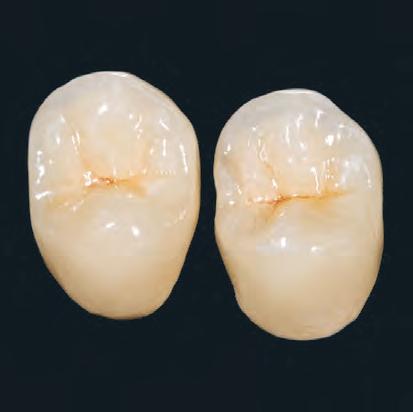


Pa Dentists (07) 577 1477
On Seventh (07) 578 3305
(07) 548 2320
